Eye-catching : Ben's "grave-digging" was born. After he went to fight green and Tibetan, he could only understand the wild winds, and he couldn't understand the technology and would not be beautiful. Something a little more than a paste, see laughable home!
There are many content pictures and the outlines are as follows. Please select them to view:
I. Introduction
Second, the appearance of the open box
Third, the architecture features
Fourth, firmware settings
1, boot and commonly used settings
2, wireless enhancement and frequency setting
3, dual dial, USB shared download and other features set
V. Performance Transmission (Wired and Wireless)
1, signal strength
2, Lan to Lan and other transmission tests
3, usb 3.0 port read and write
Six, port aggregation
Seven, mobile APP
Eight, 4K playback
Nine, summary
I. Introduction:
Someone asked me: Xiaobai you drumming these digital covets every day, those high-performance routers are useful?
My answer:
1. I was the equipment party and spent nearly ten years in the Tibetan area. In addition to seeing Rinpoche more widely than in the north, I was left behind by others.
2. Which horse do you choose? Of course, the ability to look good and strong, is the so-called " male to Pan Deng don't go idle, women want to white soft red drums ."
3, I bought a lottery ticket. In order to prepare for the future big house and full house equipment, I will buy it below.
ASUS is a brand that is determined to make progress, and its “mashup†and “innovative†products continue to break through new frontiers in business and bring endless creativity. The recent release of a series of new products such as RT-AC88U is once again refreshing. They firmly grasped the pulse of the new era and took advantage of the situation. Each step was to distance themselves from competitors and eventually embodied Asustek's "high value."
Just purchased Asus ac68u last year, followed by ASUS launched a new generation of WAV2.0 routing equipment, including AC88U, due to the "SMZDM" site love, not exclusive

RT-AC88U Performance and Parameter Summary
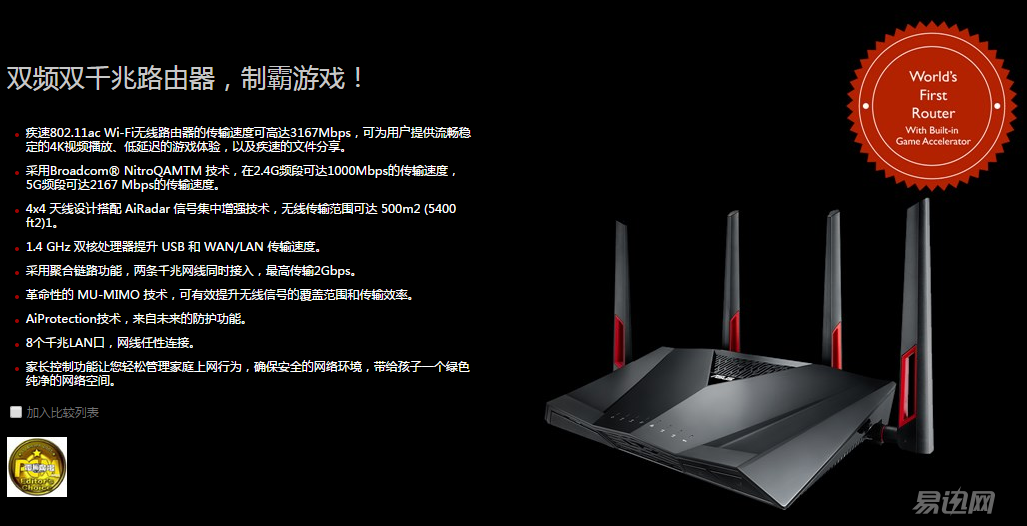
Main specifications

Second, appearance - overbearing president, but still misplaced competition
1, out of the box
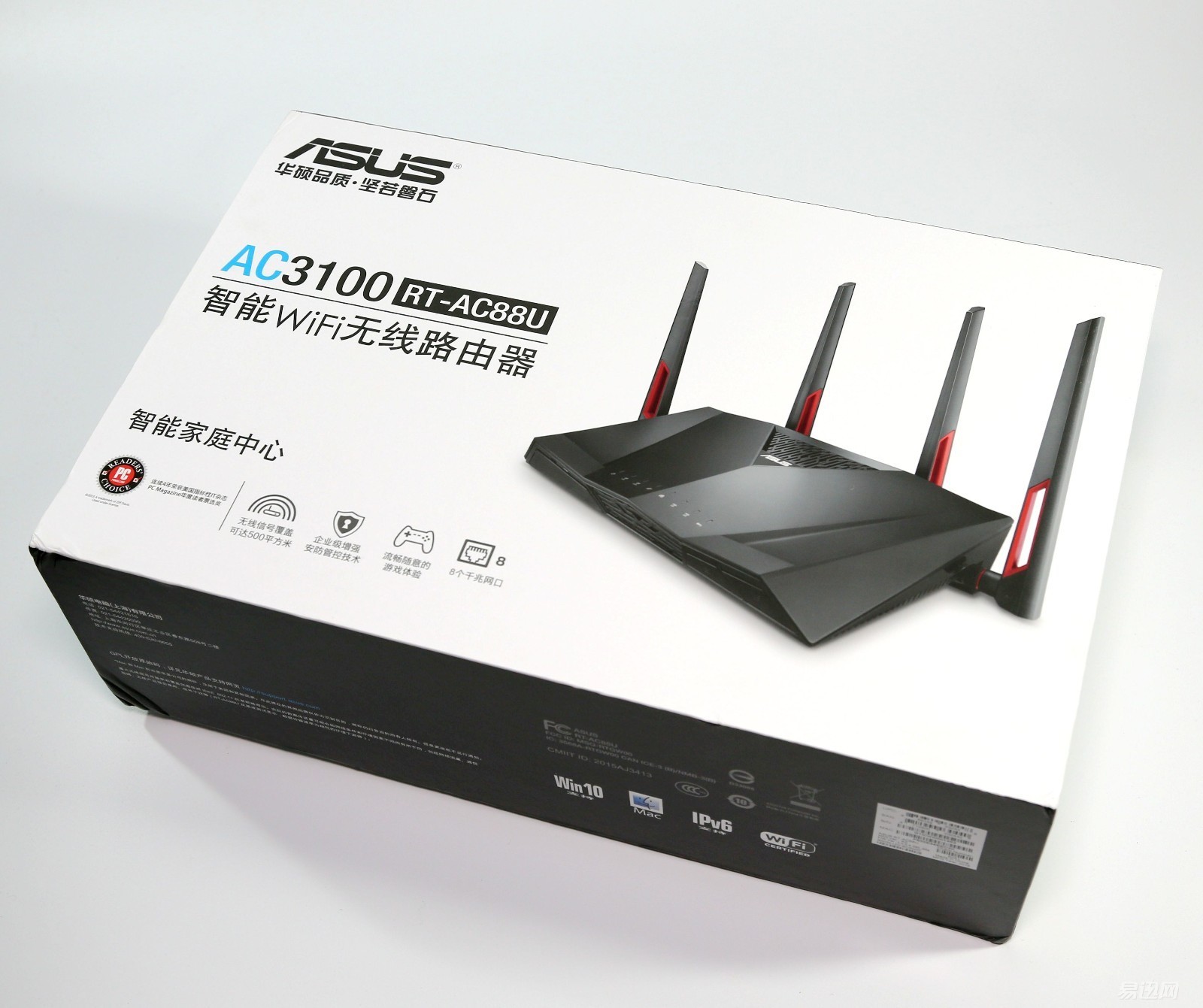
The plain white background is still very concise, eye-catching blue AC3100802.11AC Wave2 standard (supports MU-MIMO), combined with advanced 1024-QAM modulation technology, can increase the concurrent rate of wireless dual-band to 3167Mbps.
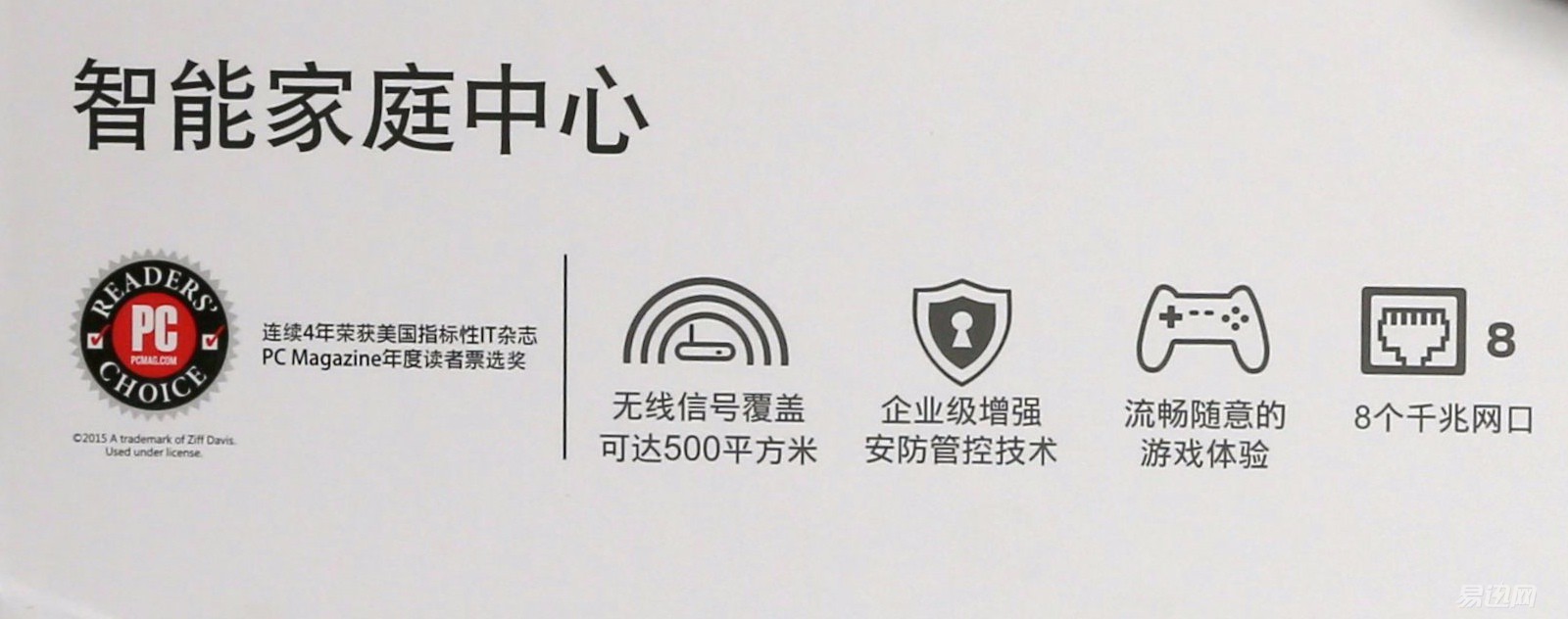
The "Smart Home Center" focuses on the role of the home network center, but the two highlights of "intelligent" and "game acceleration" make the ac88u look a bit different.
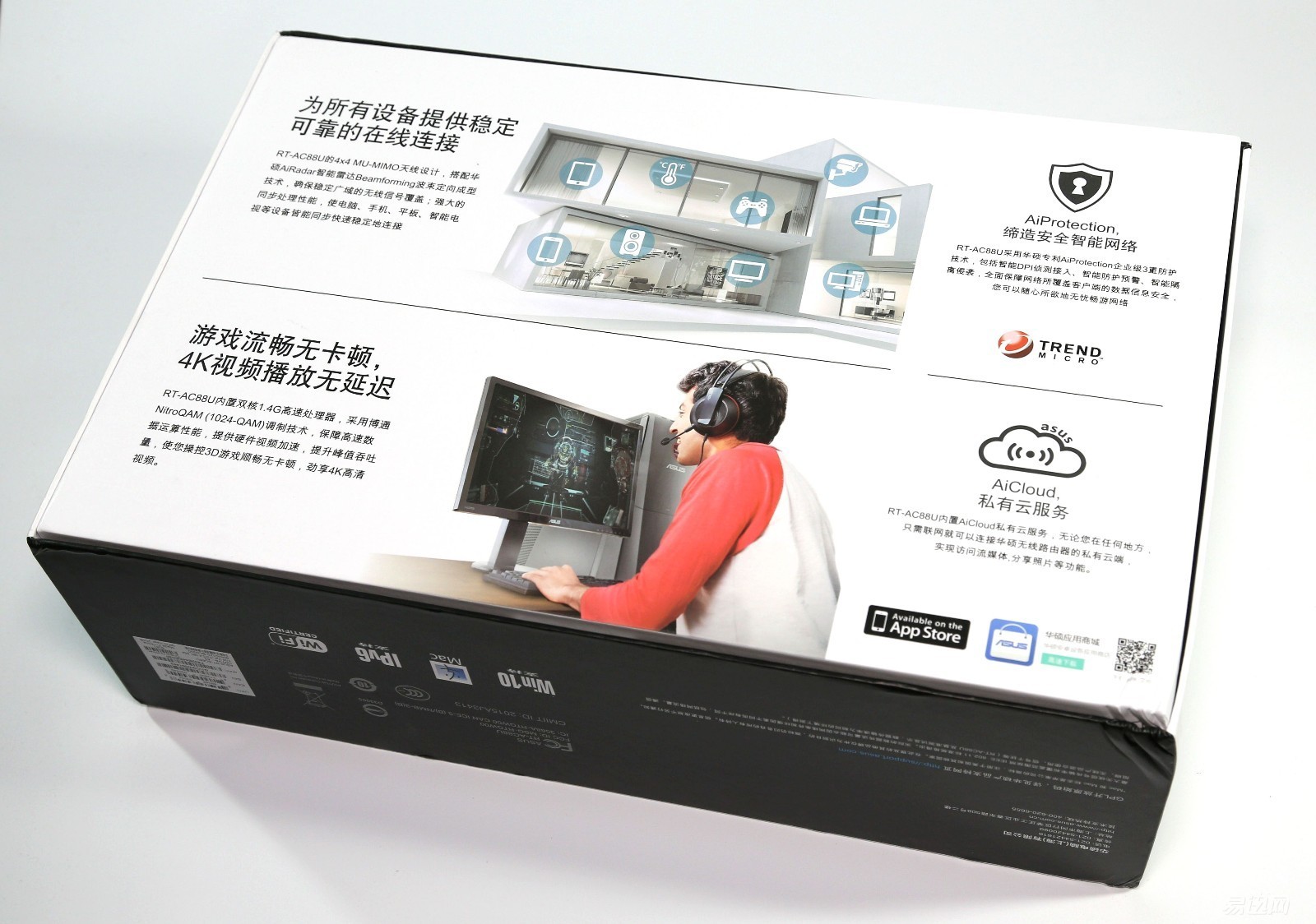
On the back, you can see more detailed usage scenarios, and exclusive wireless technology, built-in dual-core 1.4G processor, Broadcom 1024-QAM modulation, 4X4 MU-MIMO antenna technology, Beamforming beam forming technology. The lower right corner was smashed and reminded ASUS private cloud of further deepening and convenience.
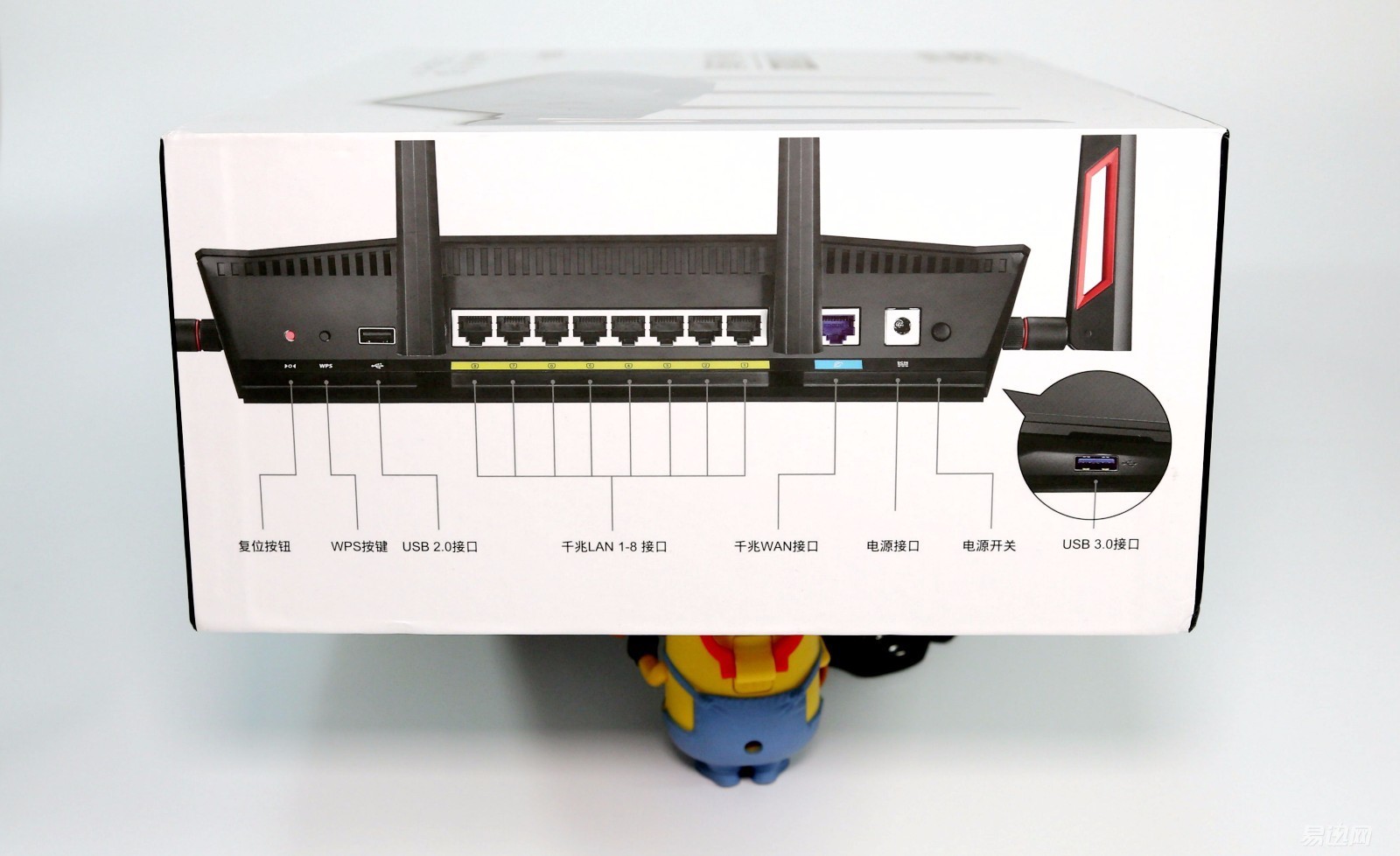
The key interface, the configuration of USB3.0, USB2.0 each one, a Gigabit WAN port, 8 Gigabit LAN port
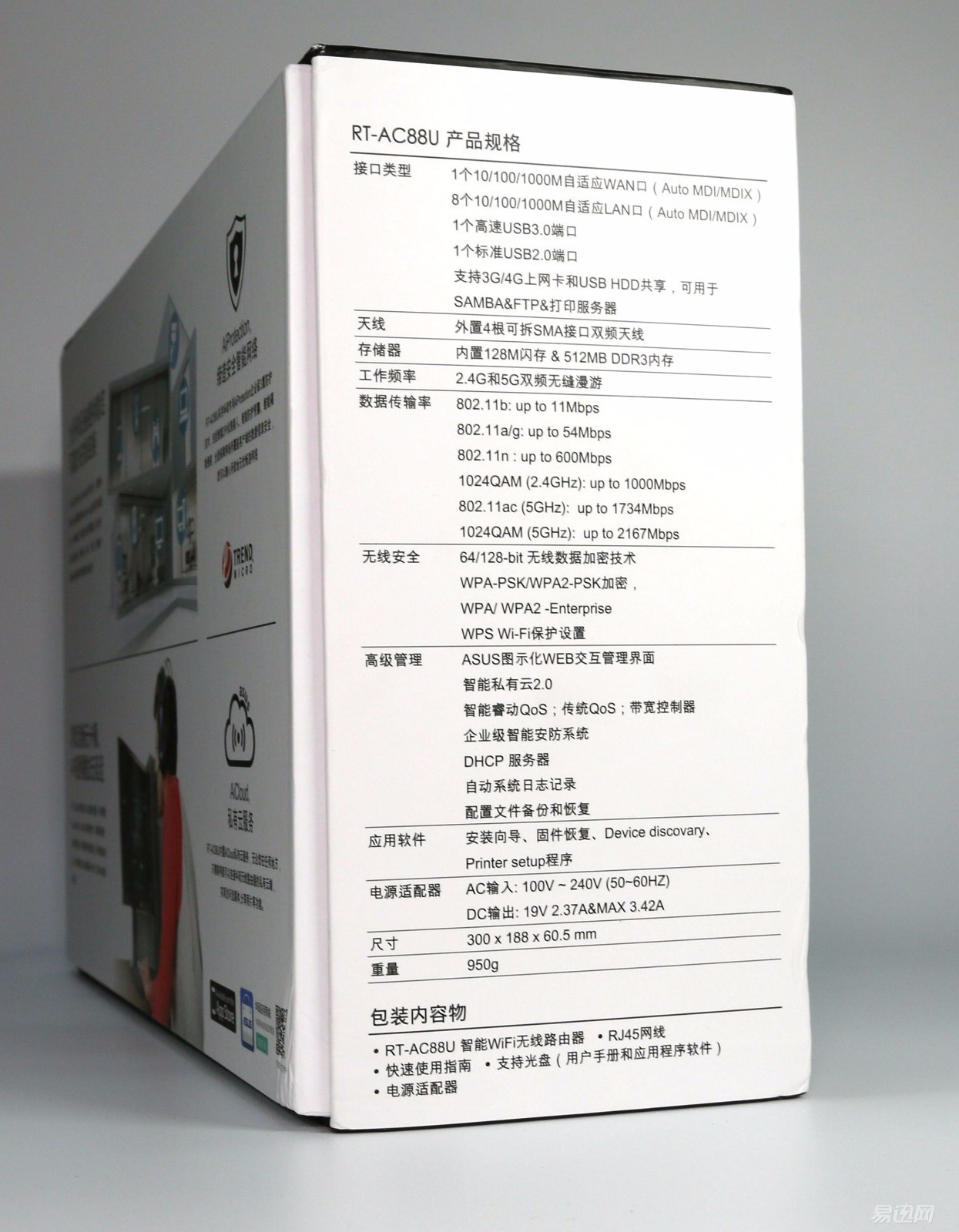
Side product specifications, please refer to the second picture
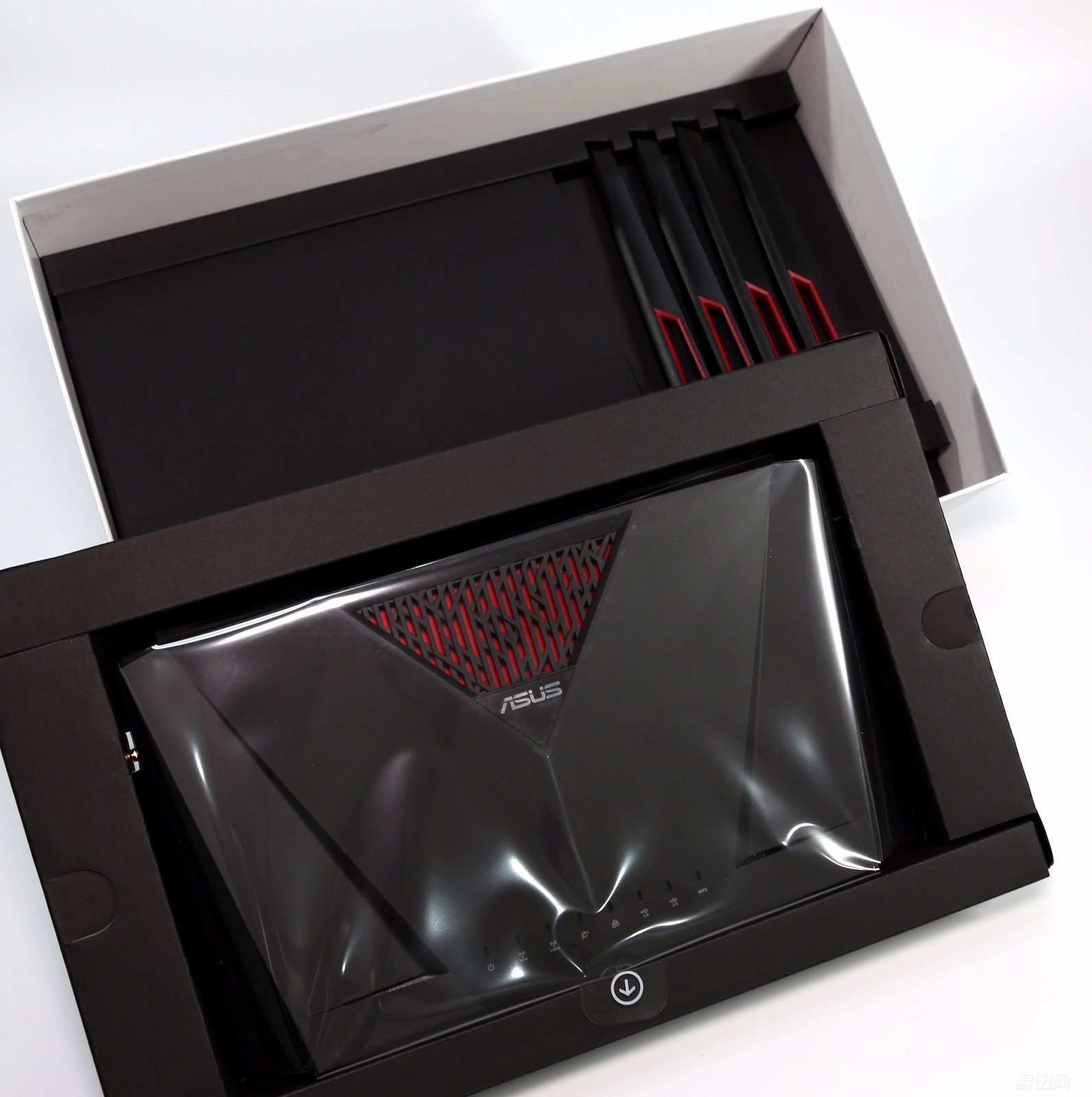
ASUS has always been the packaging style, the first layer of the router body, the second layer of antennas and accessories.
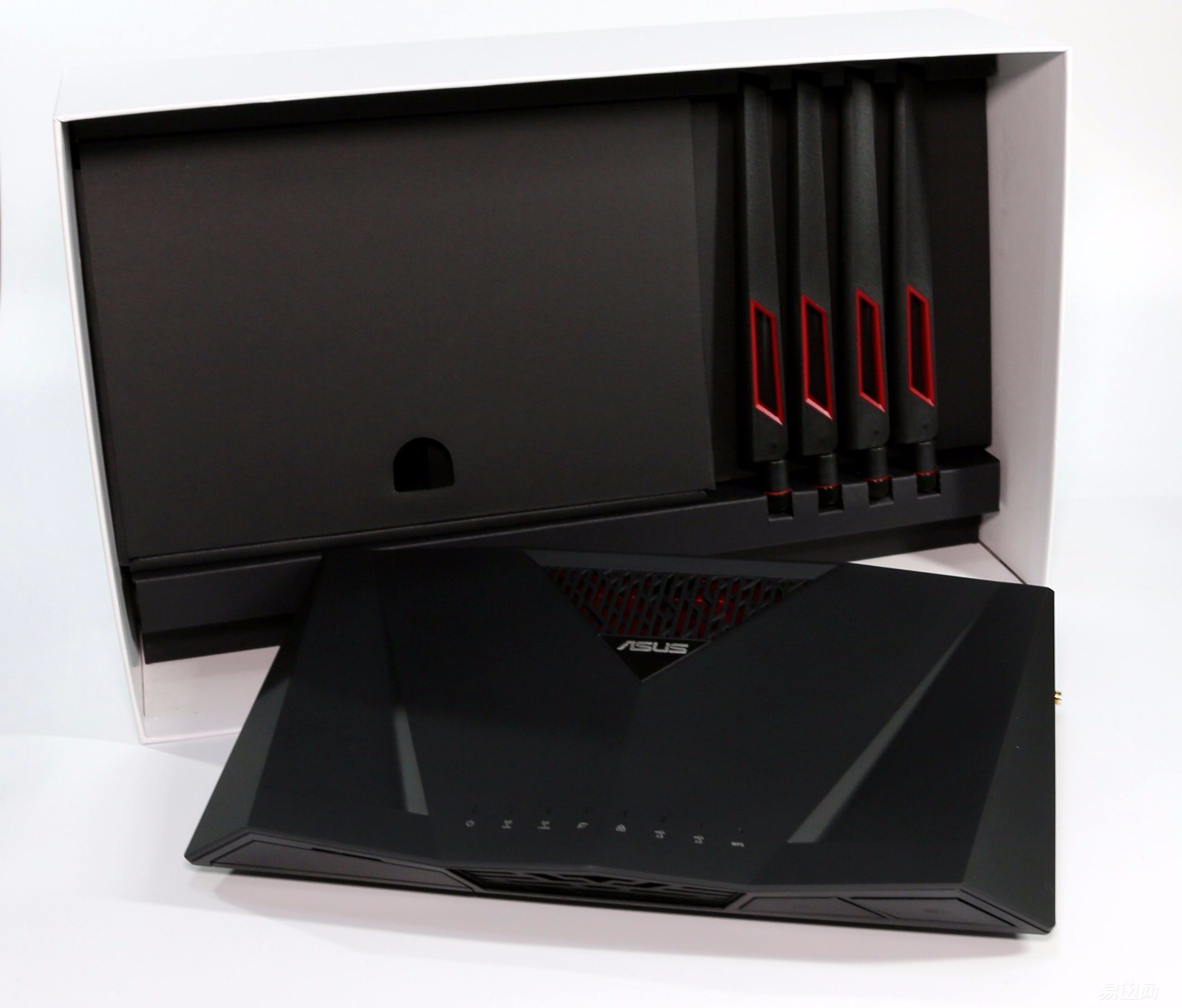
The color matching makes people contact the black and red of ROG products, positioning high-end.
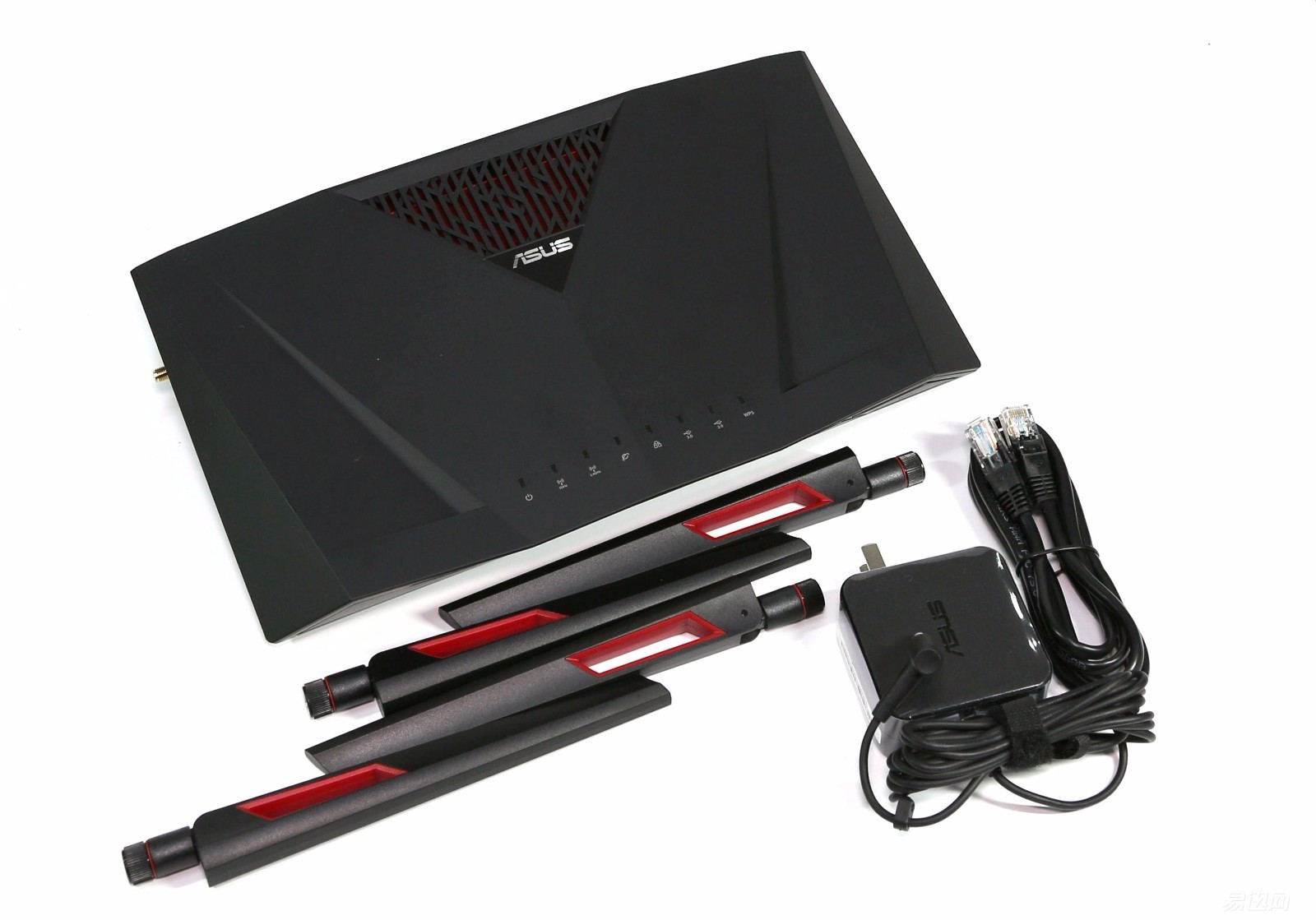
Body, antenna, and power supply
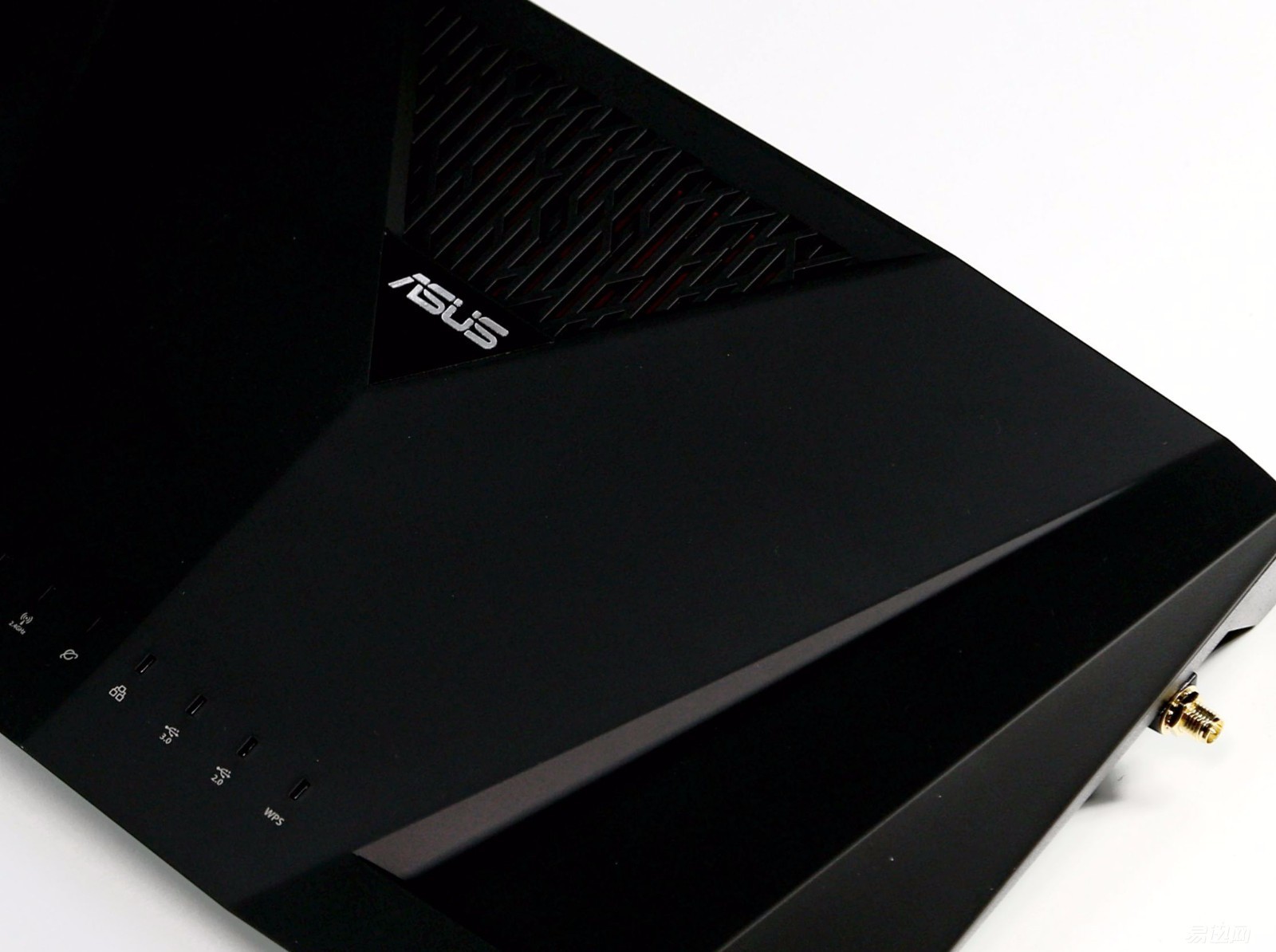
Body sports car shape, angular, matte material, but it is easy to get rid of gray, white spots at the bottom right, right, is this, not your monitor is dirty, is dust, dust, dust ...

The central axis line is highlighted, eight indicators, corresponding to: power, 5G, 2.4G, networking, LAN, USB3.0, USB2.0, WPS

The front left USB3.0 interface, different from the 68u USB port will be placed behind the fuselage, more convenient, I do not know whether there is anti-interference considerations? In addition, it also has a dust shell protection, and the details are good.
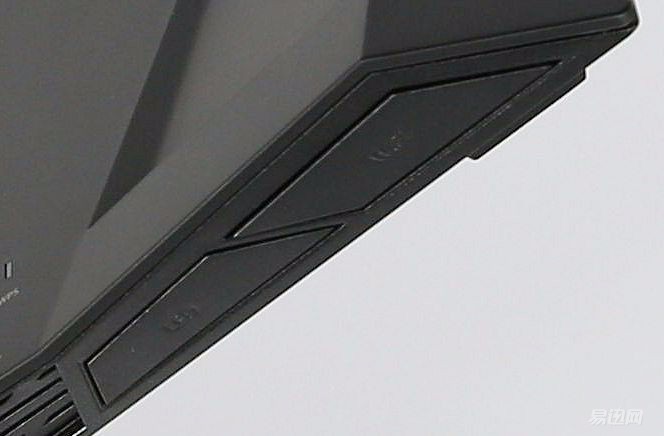
The lower right, LEDE / WIFI key, but the key surface is too wide, always not on the right position
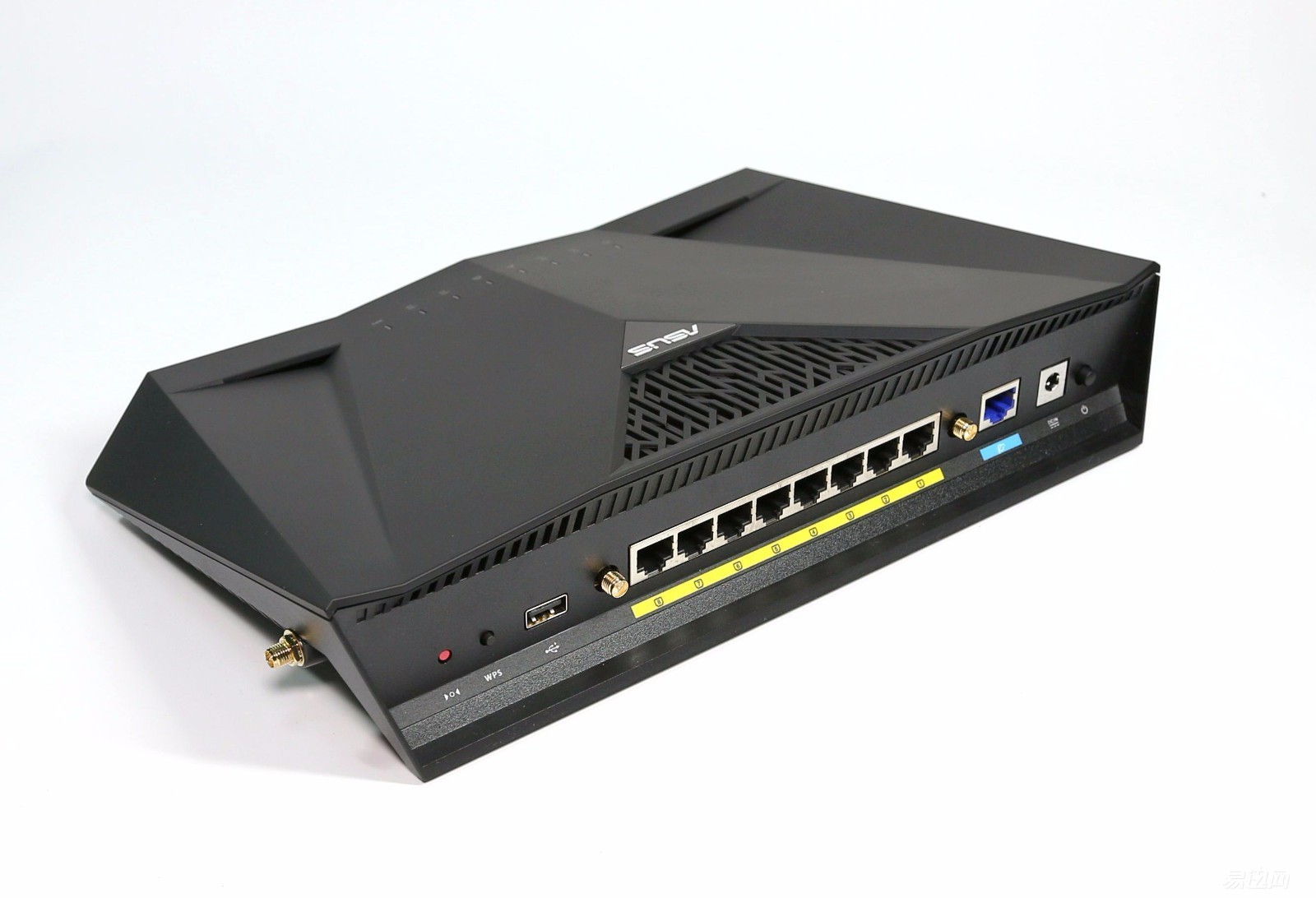
Chrysanthemum at a glance, from left to right: red reset button, WPS one-button switch, USB2.0, 8LAN, 1WAN, power jack and power button 8 Gigabit interface design is also relatively rare in home routing, can be Some users with more wired access need to save a small switch. The RT-AC88U's LAN1 and LAN2 interfaces support "link aggregation," which is obviously superior and shielded.
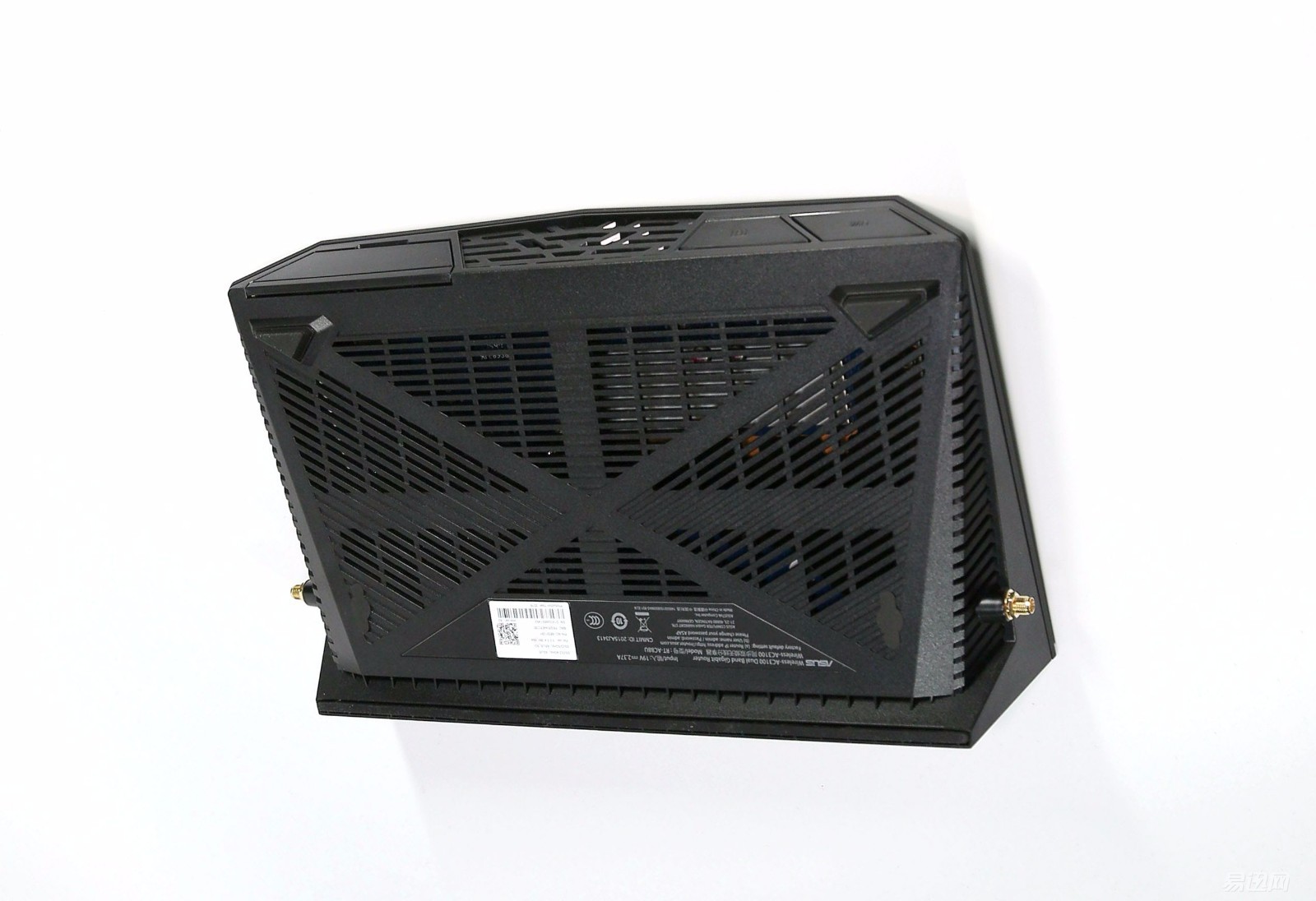
Back, using a large area of ​​open mesh, to ensure heat dissipation, non-slip foot pads at the corners, there is a rubber strip up and down

Attached list, three-year warranty is very kind

Robust 4 antennas, hollow at bottom

Compare the AC68U antenna to understand

19V 2.37A power adapter, 45W, apparently for more mounting services
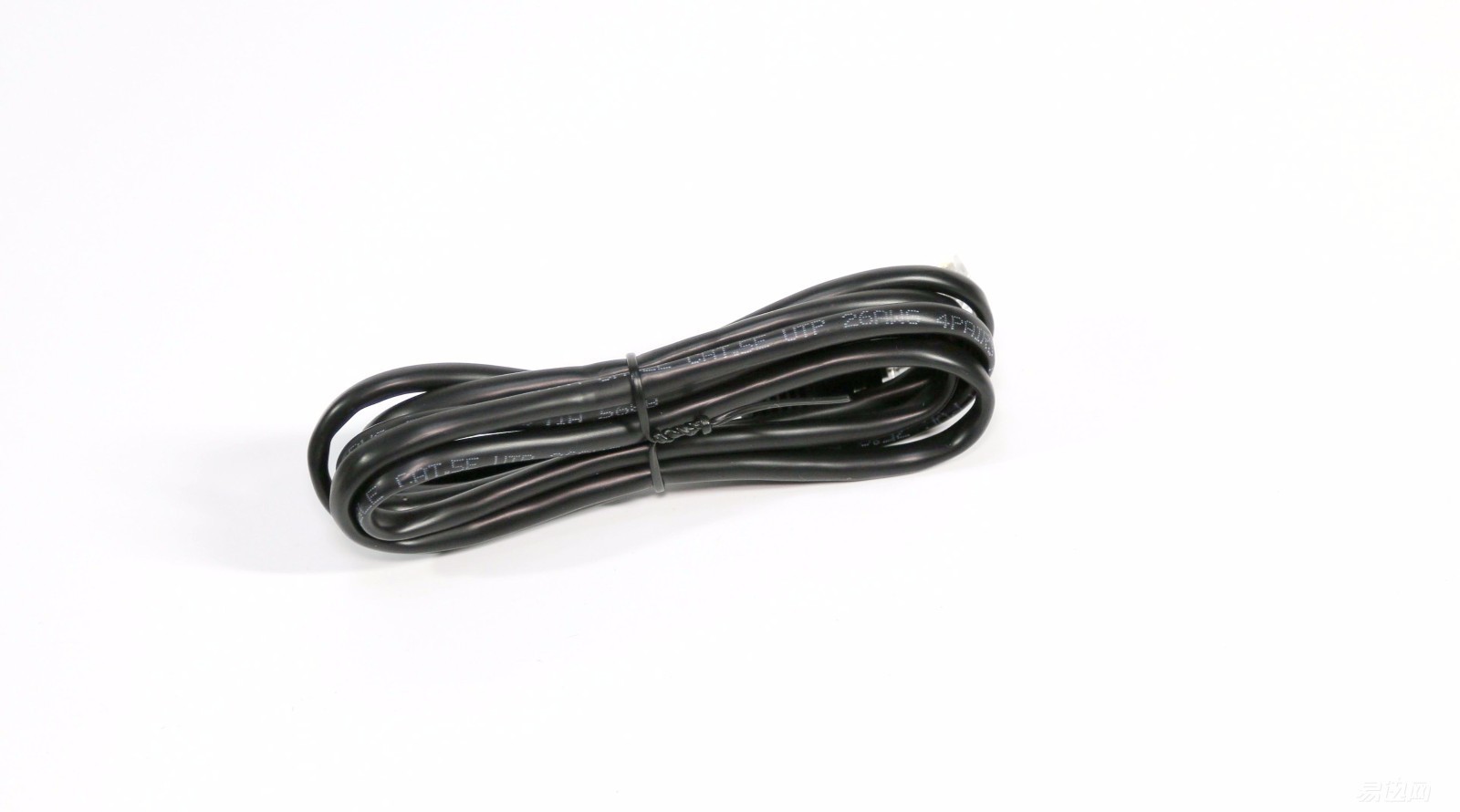
In contrast, CAT5E's wire is slightly LOW
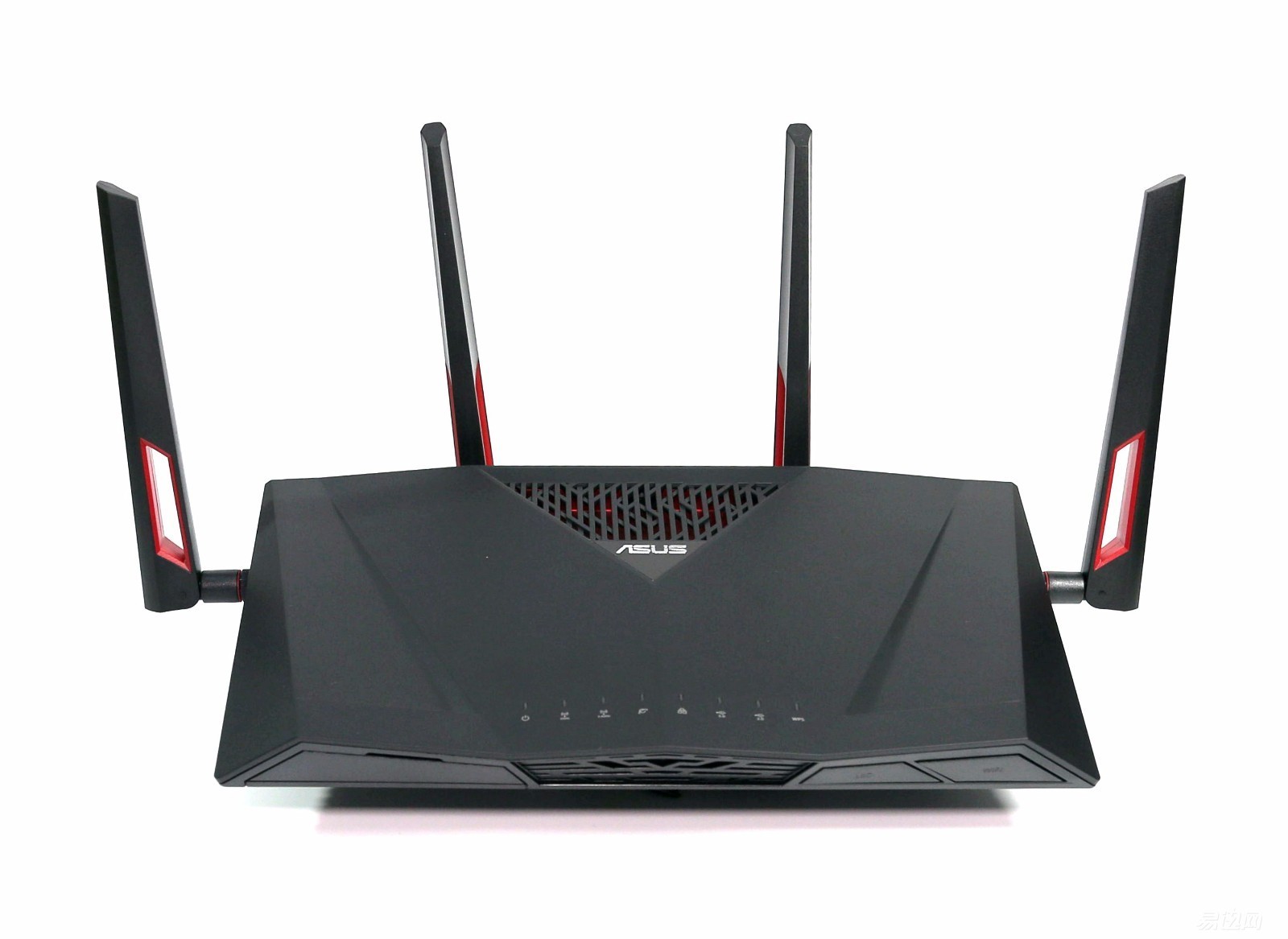
Fit front view
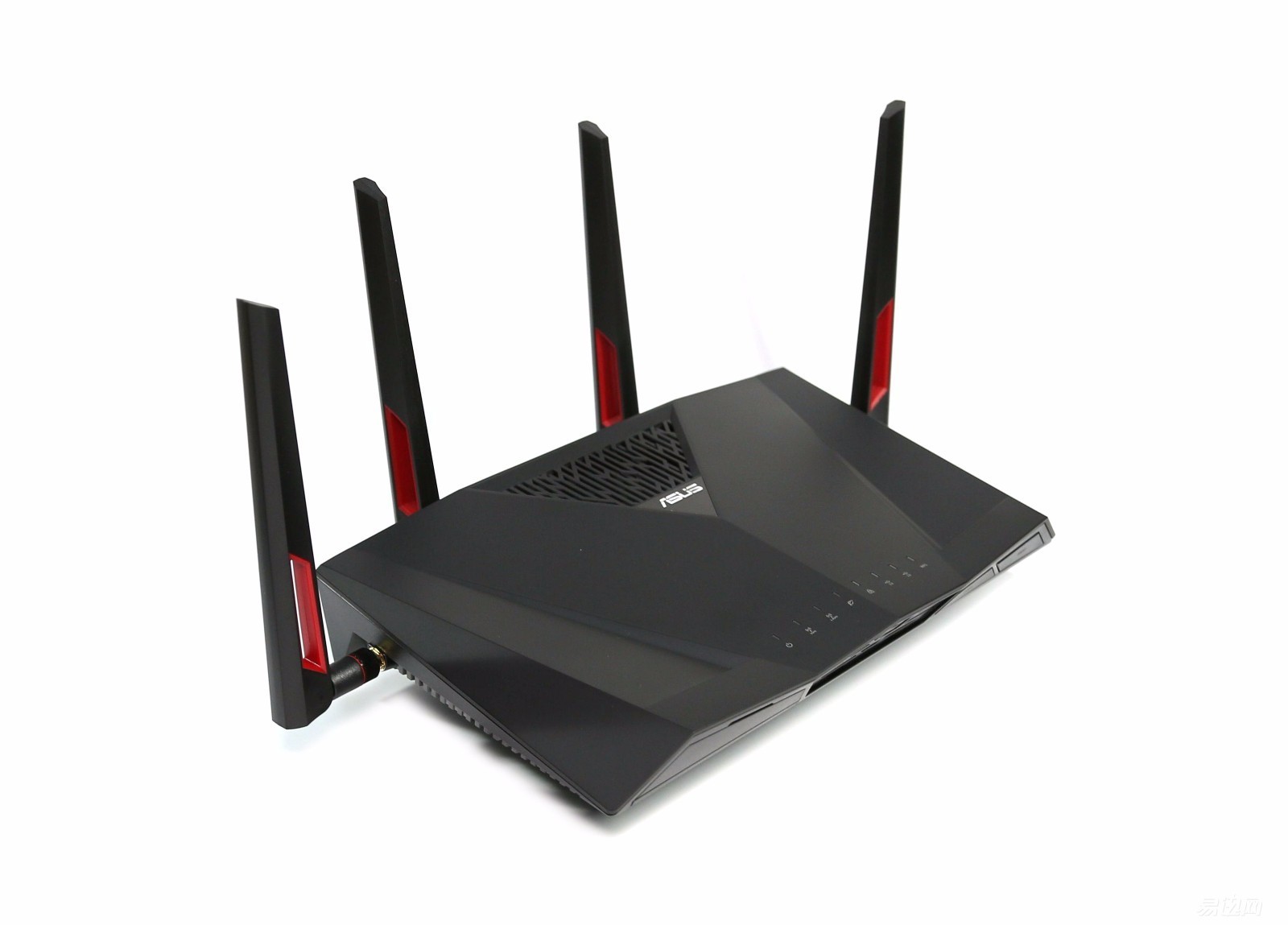
Seen from the side, the driving momentum is just too many edges and corners, the plastic feels slightly stronger

With the previous generation flagship together, a full circle, plus two antennas, how to place my small bookshelf, so people tangled. In addition, although the horizontal shape is very domineering, but not as good vertical thermal performance, therefore, ASUS specifically in the top of a large cooling hole in the inverted triangle.

Front vents, a large red heat sink faintly visible, once again emphasizing the "ROG" family lineage to increase visibility


In addition, four groups of antennas can be folded and steered within a certain range to enhance wireless coverage.
Third, the architecture and technical advantages
1, configure the chip:
The ASUS Rt-Ac88u router uses the main chip of Broadcom BCM47094 and two BCM4366 wireless chips, 512MB of memory and 128MB of flash memory. At the same time it breaks through the 5-port design of traditional consumer routers and is equipped with 8 Gigabit LAN LAN ports. One Gigabit WAN port. The configuration of the stacking material is obvious, you can compare the next few flagship products

ASUS routers rarely hear "shrinking" rumors, and a large number of teardown evaluations have proved this, plus AC88U has a wide range of metal shielding, I worry about the demolition will not come back, so the following chip picture taken from the network, thanks Koolshare users "ALEX ".
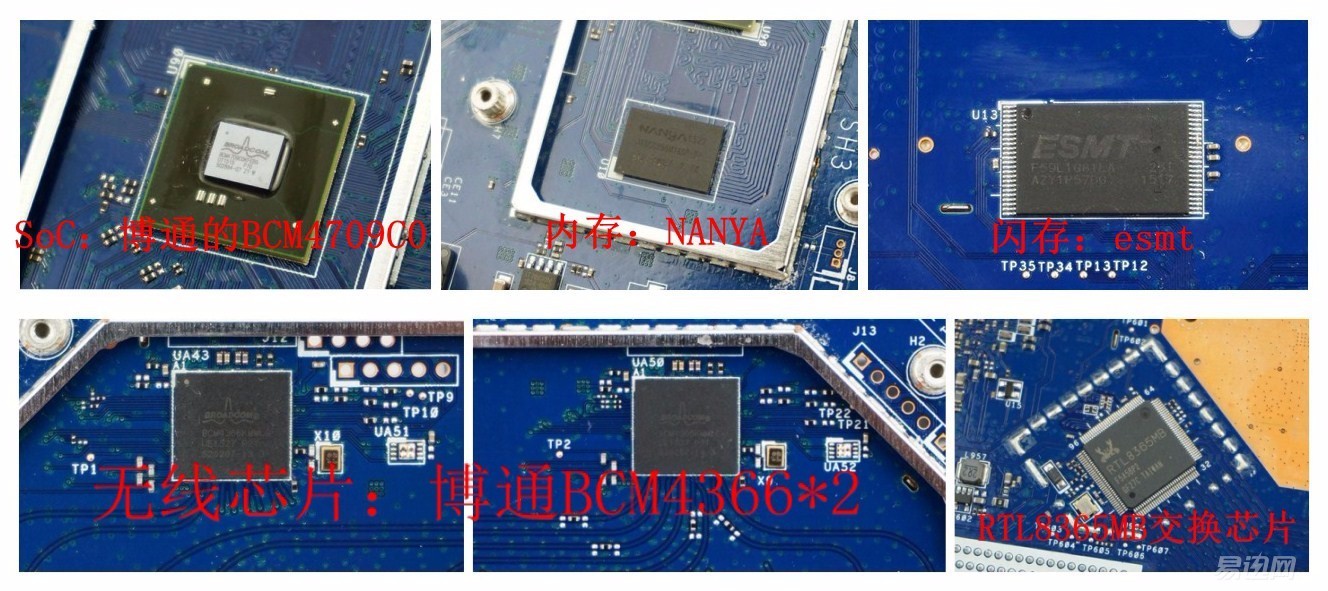
Two of the BCM4366 wireless chips from Broadcom are responsible for the 2.4G band, and one is responsible for the 5G wireless chip. This is the same as the configuration of the top-tier flagship R8500, which also supports MU-MIMO, supports 4-way MIMO, and supports 1024QAM.
2, MU-MIMO
As a technical sign of the era of 802.11ac 2.0, the picture shows it

The so-called "MU-MIMO", according to the popular AC88U understanding, ac88u data exchange at the same time four devices, it is like su-mimo is a single-lane highway, this lane has N cars, but only at one time Pass a car. MU-MIMO is a four-lane expressway that can pass 4 vehicles at a time and is highly efficient. (It needs to be emphasized that WiFi terminals must also support MU-MIMO technology)
In addition, beamforming signal concentration enhancement technology and NitroQAM modulation and demodulation technology also need WiFi terminals must also support in order to maximize performance. Specific to the setting of AC88U I screenshot as follows:
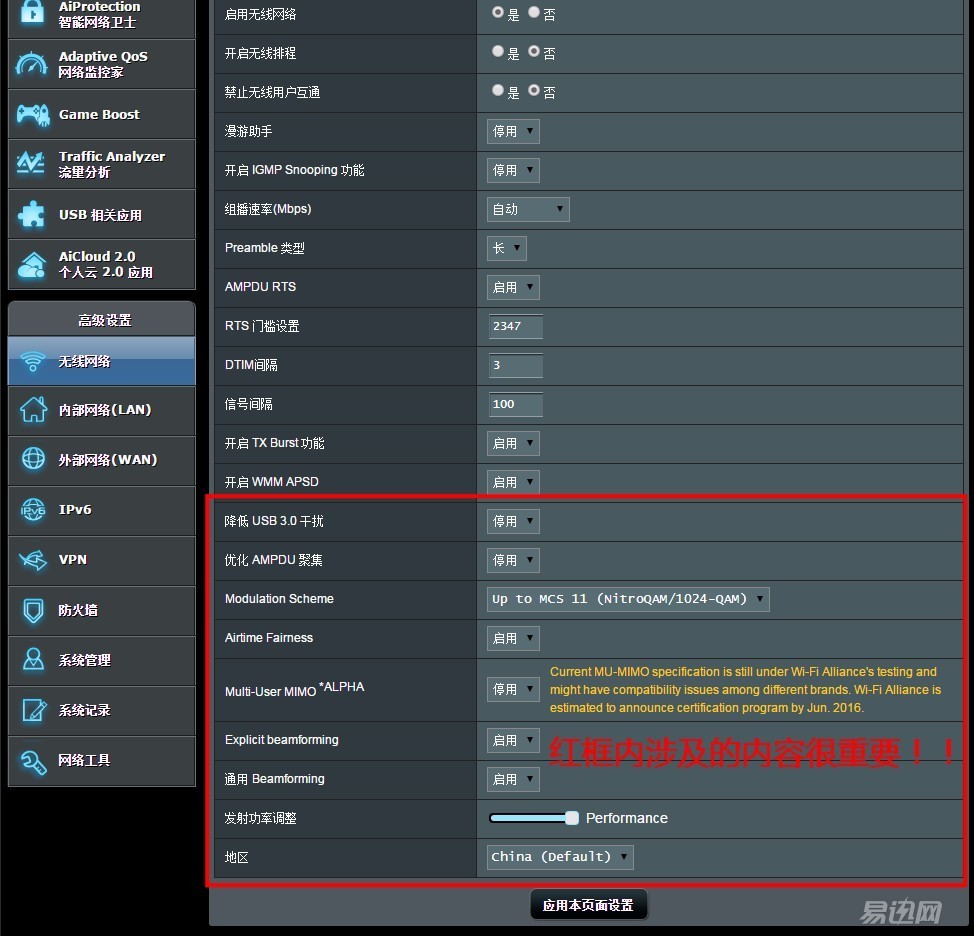
My wireless network card installed ASUS driver, after opening the above settings, the current wireless speed is:
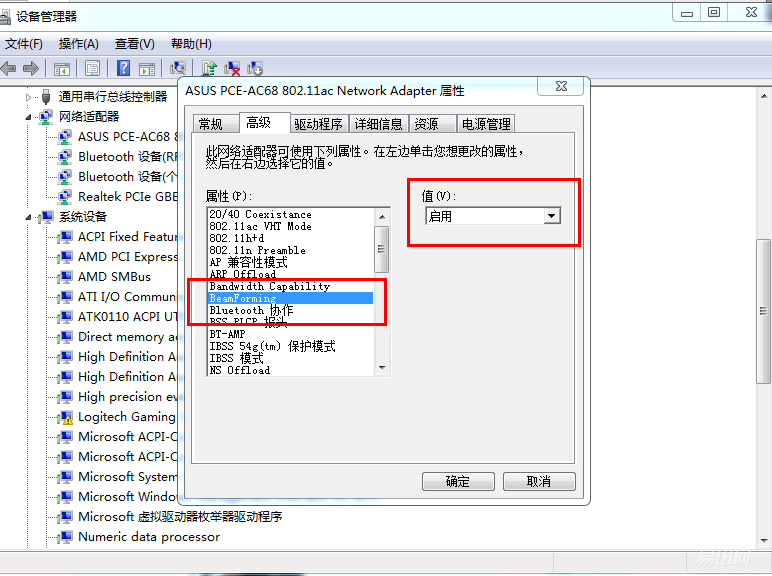

The maximum speed of 2.4G nominal 450M has been measured at 280M. Due to the lack of corresponding QAM modulation drive, the maximum theoretical value of 600M does not have to be extravagant. The 5G part has reached 1.3G due to the corresponding QAM modulation, so the total is about 1600M.
3, Gigabit exchange chip expansion
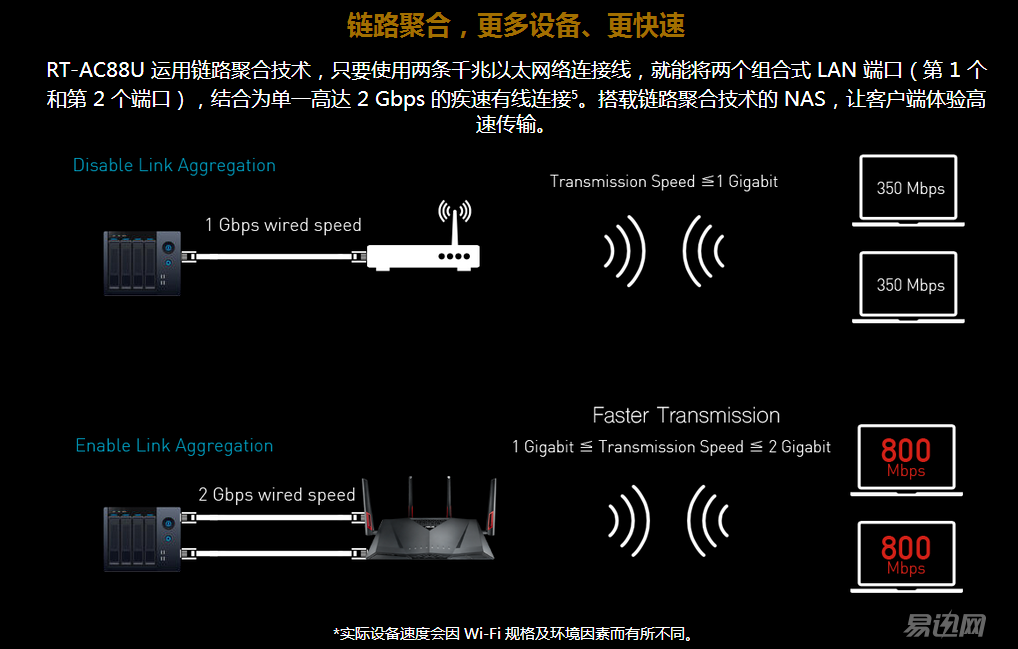
AC88U 8-port Lan, looked very practical, in fact, two switch modules, Lan1 ~ 4 is BCM47094's own Gigabit switch module, which Lan1 and Lan2 support link aggregation, Lan5 ~ 8 is the crab RTL8365MB exchange chip extension. We also hope that there will be a single chip directly responsible for all eight ports like many aggregation switches such as the Cisco SG200-08, so that the port aggregation will not be as weak as it is today (please refer to the following test in this part).
Summary: Compared to the R8000 at the same price, ASUS likes to drop some of the configuration and technology of its top-level flagship (R8500) to mid- to high-end products, thereby further pulling the difference.
Fourth, the firmware settings
Asustek has always been known for its powerful features, intuitive simplicity, and fast and efficient firmware. Moreover, semi-official firmware such as “Merlin†is indeed attractive. Because of the space and personal level, this article can only be introduced in detail, and it is more dependent on the friends to explore for themselves.
1, boot settings
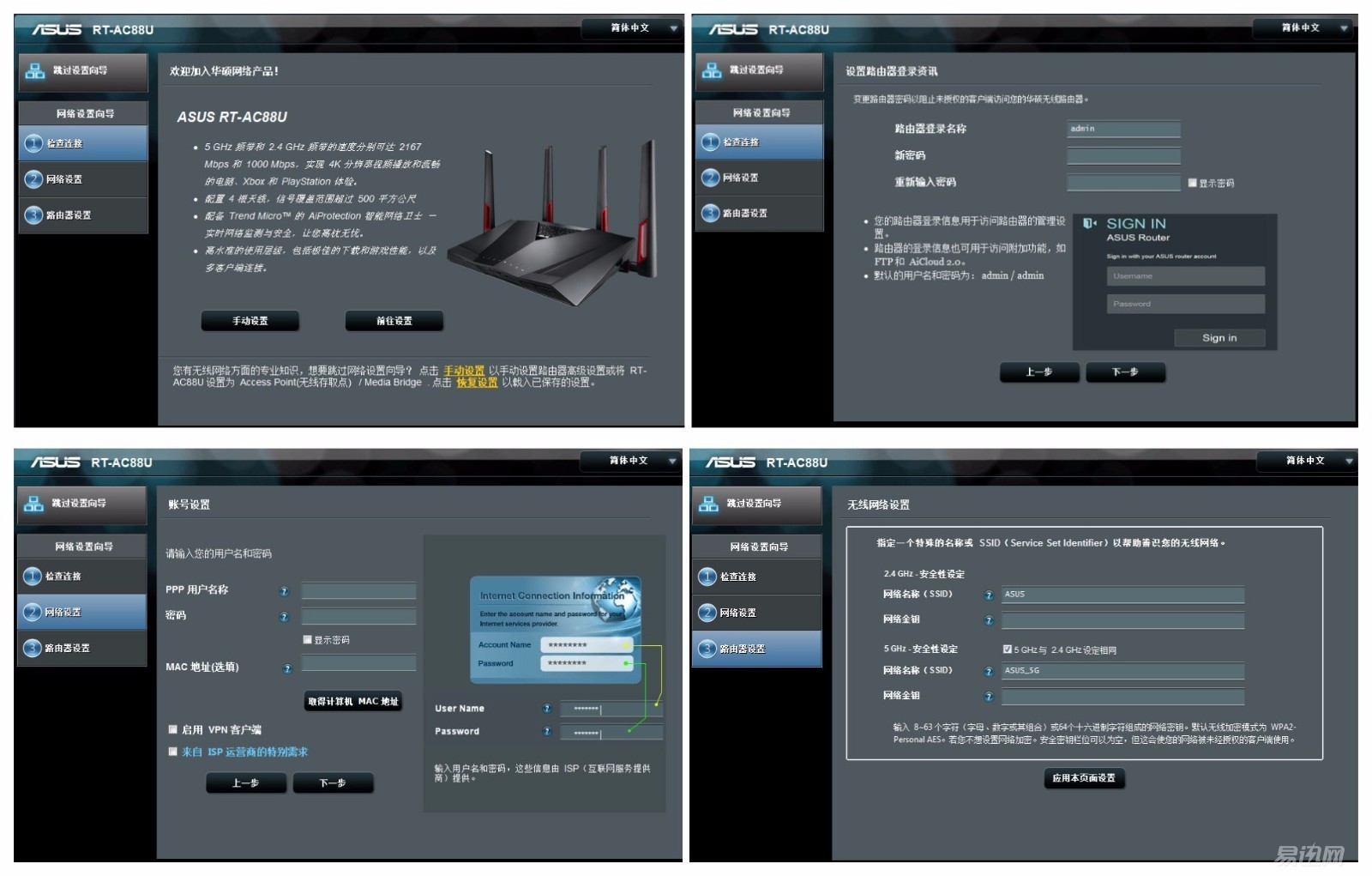
Enter "192.168.1.1" to enter the login name modification, PPOE account input, wireless password settings and other input and use information.

On the login screen, the bar is clear. On the left is the “function areaâ€, and on the right is the connection information area. You can see the “Network connection†status at the top, the “Load device†information at the bottom, and the system information at the far right.
2, security and monitoring
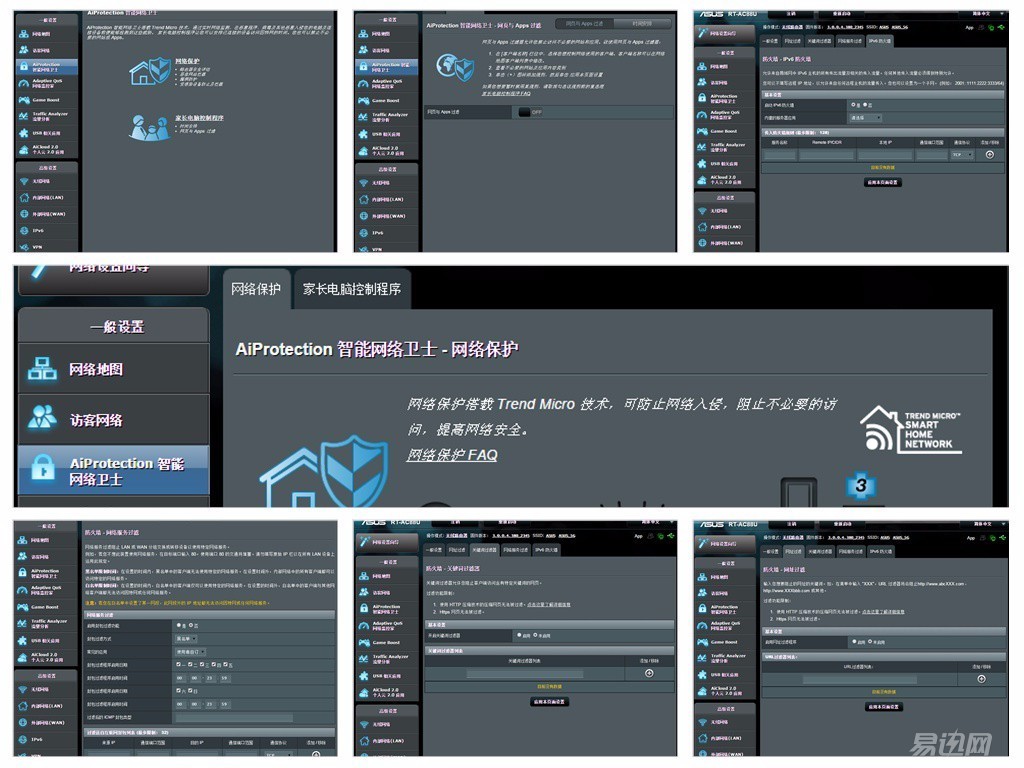
The high-end routing function is extremely rich, and ac88u is the main player in the outer package of "security card", providing more safety and monitoring items to implement self-protection awareness. Parental controls, content filtering, firewall services, etc.
3, traffic monitoring and management

Super-powerful Adaptive QoS monitoring function that can monitor each device's program access to the network, the chart format is non-intuitive

And through pre-definition, drag and drop settings, set the priority of applications and applications of the incoming and outgoing bandwidth, such as games, streaming media and other applications with higher bandwidth requirements. For example, in this paper, the bandwidth setting of music streaming media is relatively large.
4, game boost function
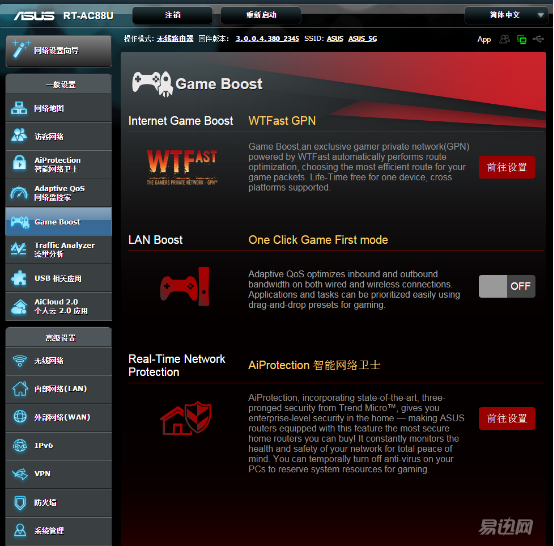
In fact, it is a further guarantee of the game networking bandwidth, and the priority is guaranteed in both WAN and LAN.

The RT-AC88U is equipped with a built-in client and WTFast Player-Specific Network (GPN), which optimizes WAN network routing through a dedicated GPN server to ensure stable low ping times and reduce packet loss. Of course, this time it needs to pay.
5, professional settings and features
A, dual line (double dial function, dial out the door left to find Merlin, do not ask me, I can not even double dial here)
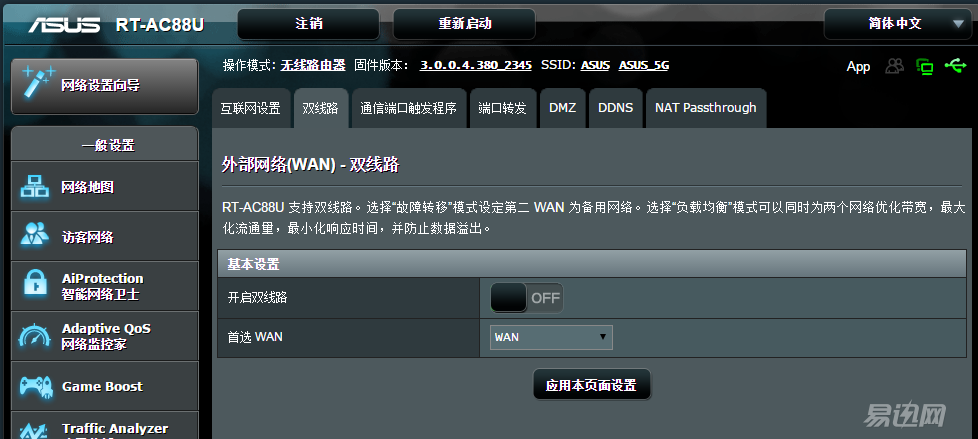
For details, please refer to the previous settings in 68u.
B. Link aggregation
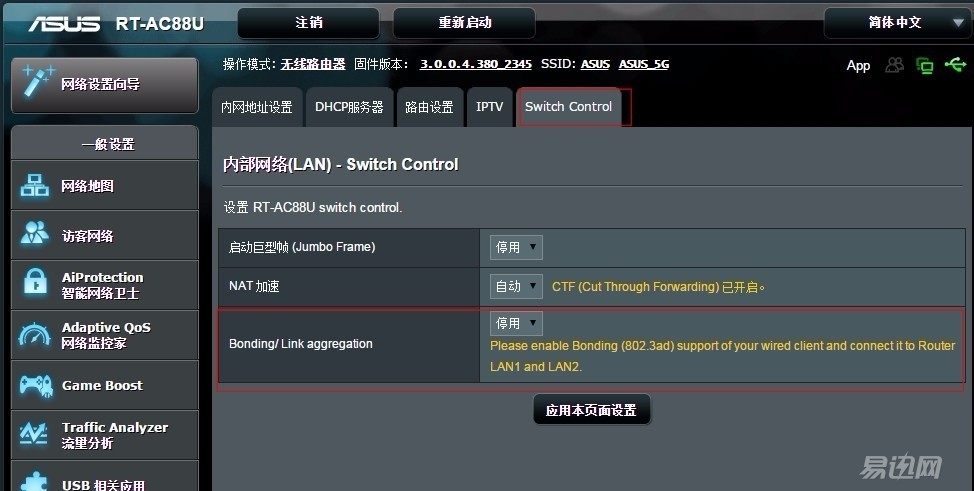
AC88U's LAN1 and LAN2 also support link aggregation, which can be enabled in the Switch Control of the internal network when terminal support is required.
C, VPN

D, wireless performance settings
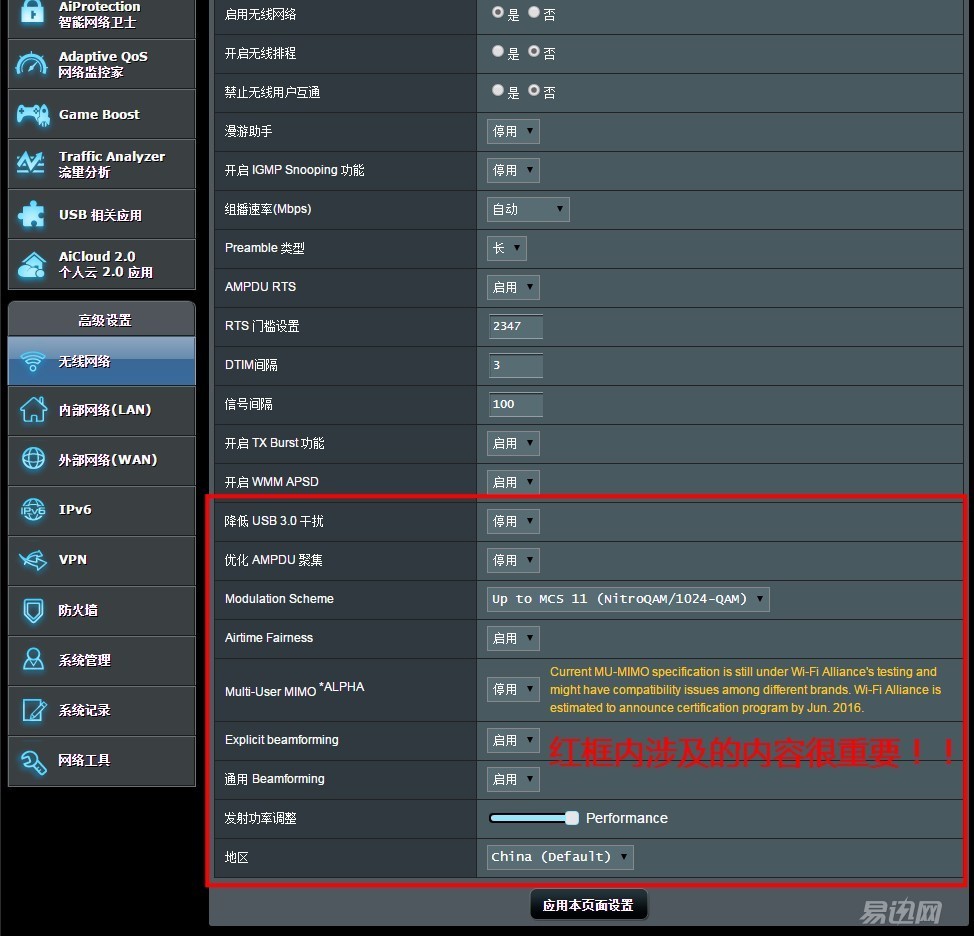
Can set 2.4G, 5G channel frequency, change the area, open, close USB3.0 anti-jamming and beamforminge and other functions
6. USB and AiCloud Private Cloud Settings
A, USB sharing and download
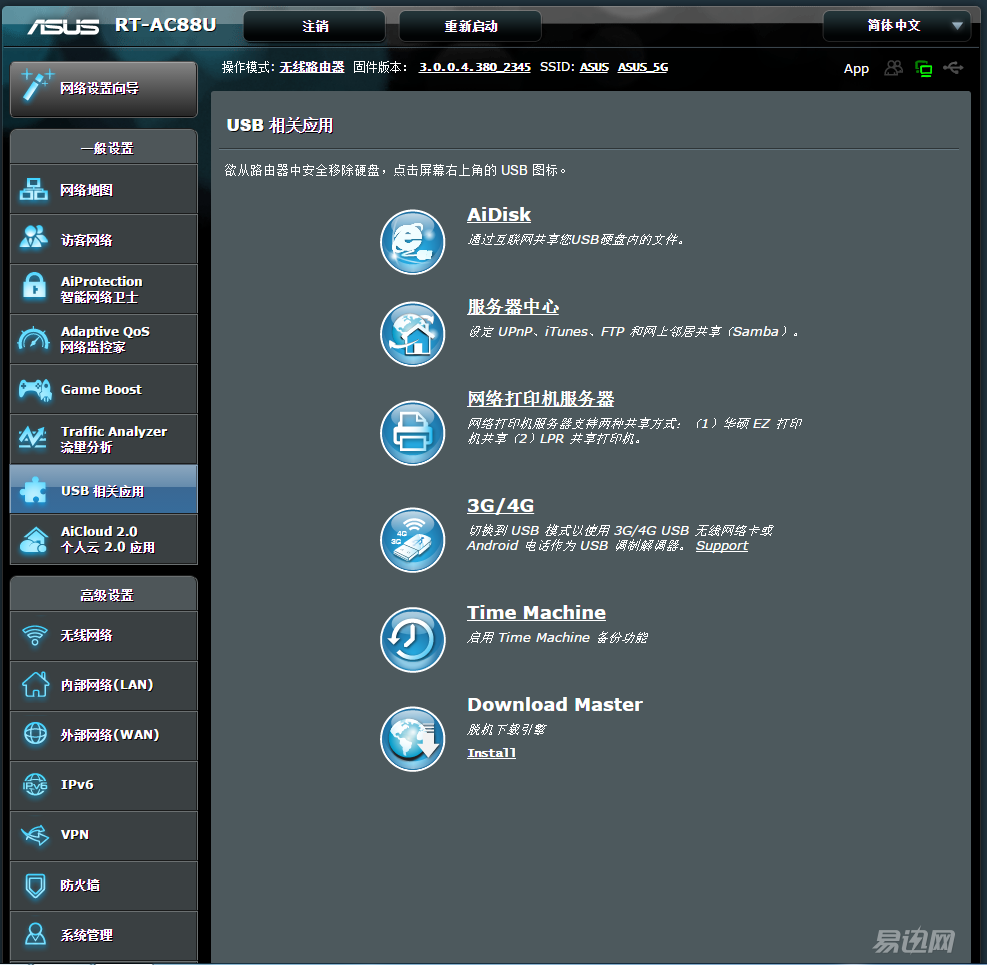
First open SMB sharing

Then install the download master to set and display the download function
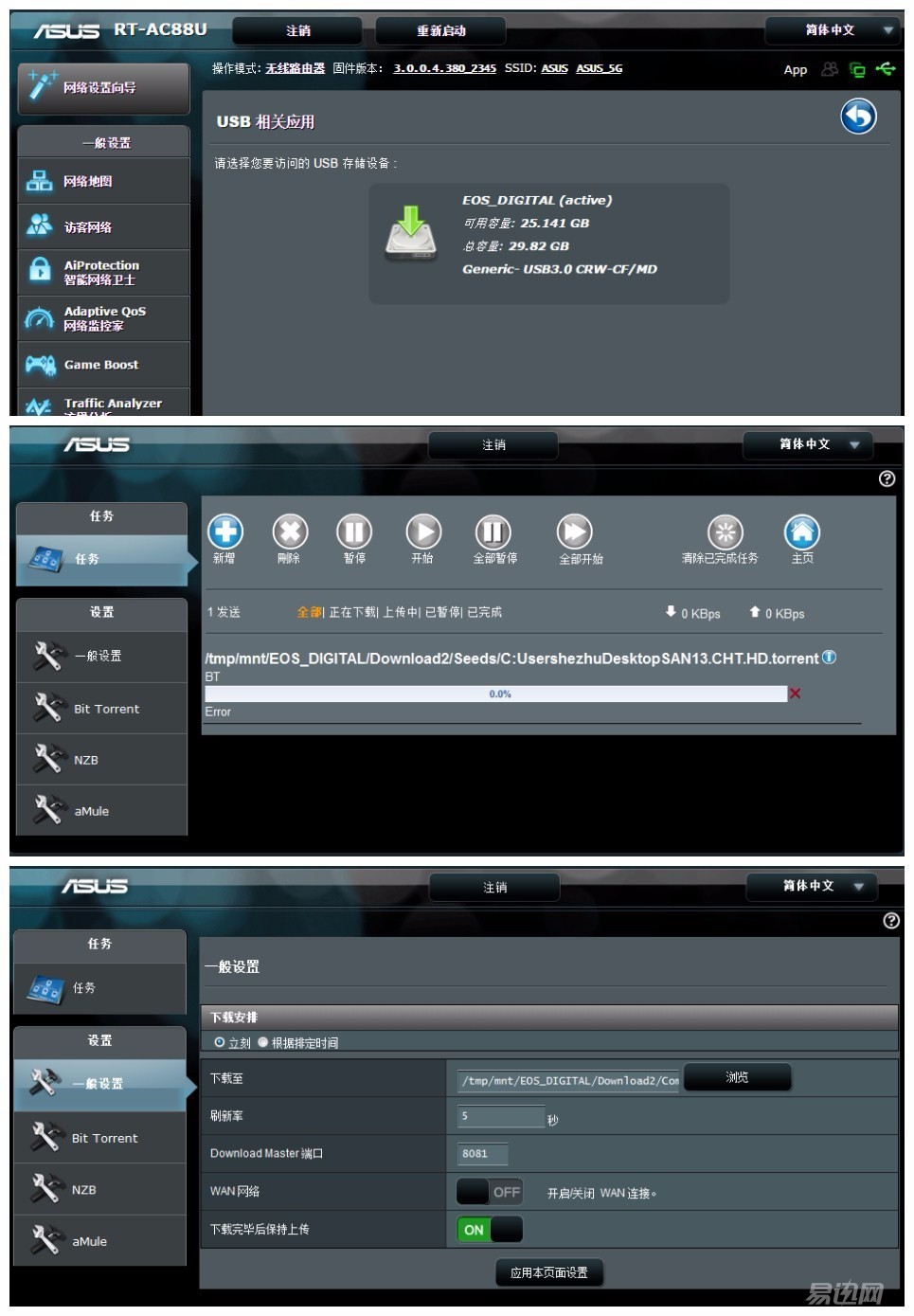
However, the landlord really does not need this function will not test speed, in addition to Merlin firmware can be installed "Thunder Remote" is very convenient.
C. Private Cloud
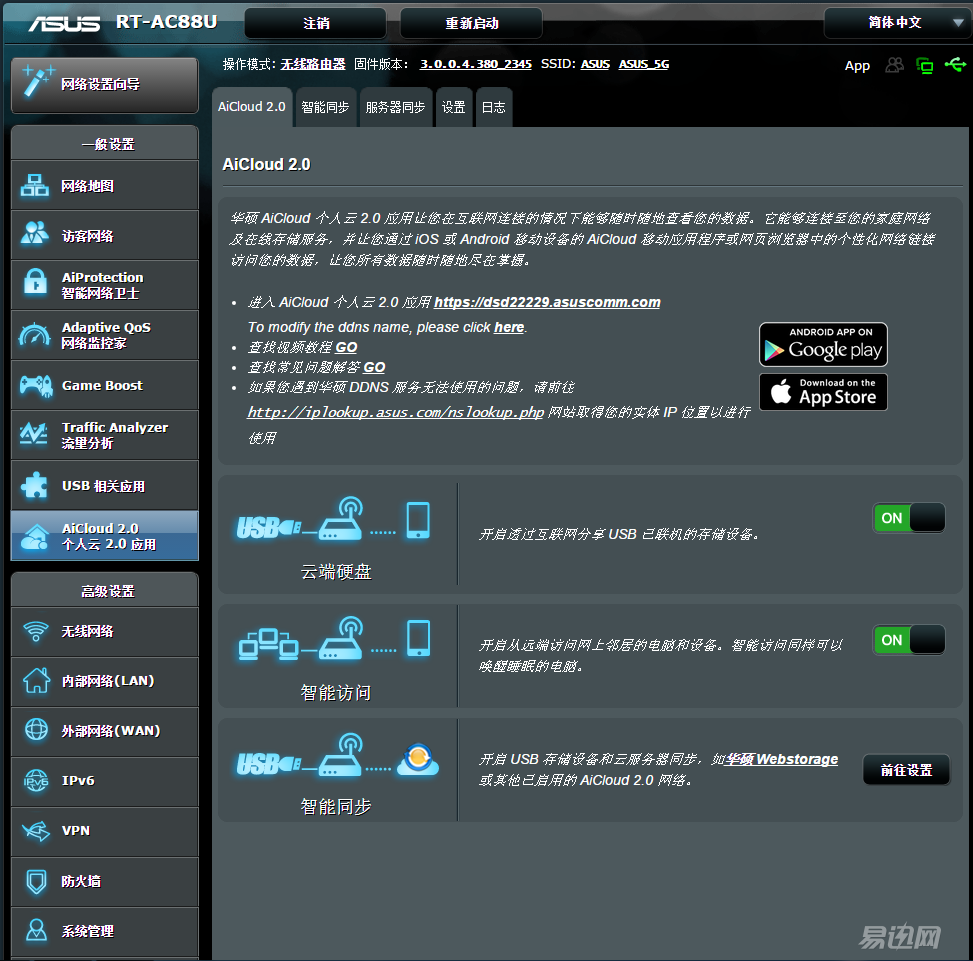
With the mobile phone APP, it can be downloaded at any time, read at any time, and be backed up synchronously. This part of the content is detailed in the mobile phone APP and performance tests.
7, link management
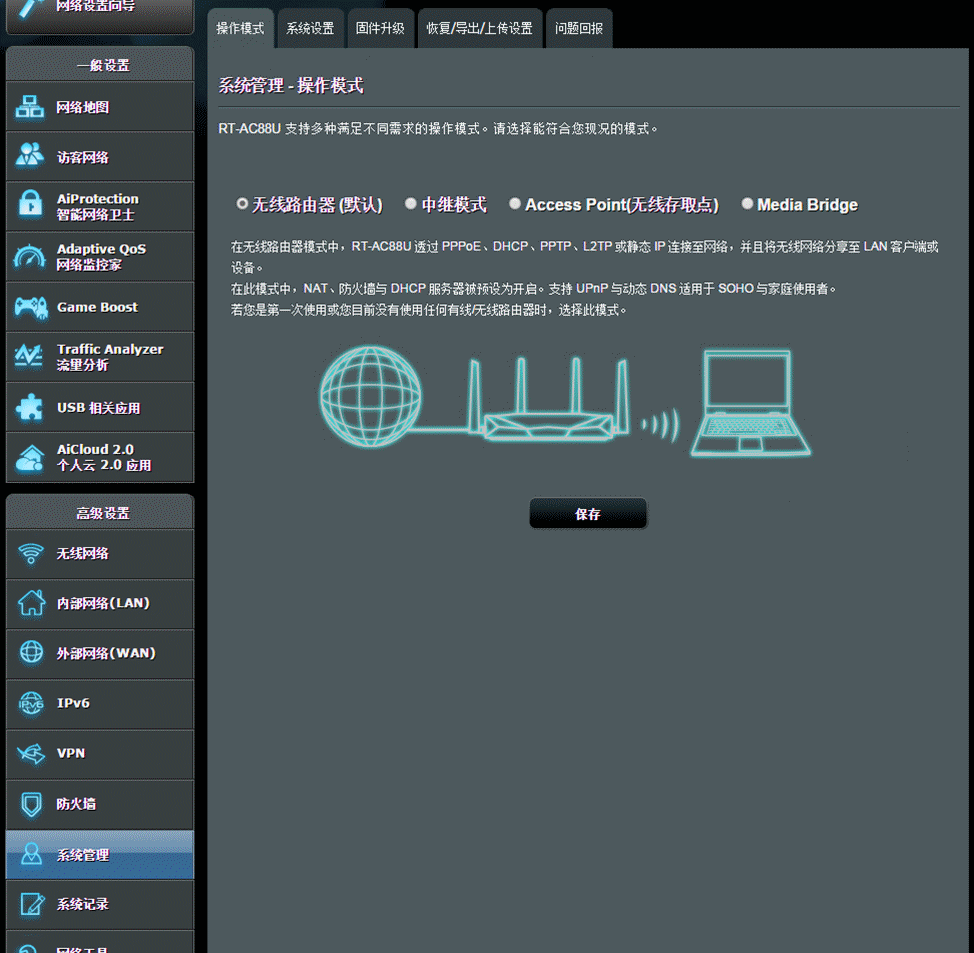
What is more interesting is the last way, with two routers, using the 8LAN port of AC88U to use it as a pure Gigabit-chained switch, but the cost is a bit high, huh, huh!
Fifth, performance testing
(a), test preparation
1. Main connection equipment of this white home, Category 6 Gigabit LAN environment

Asus ac68u+ general switch (without aggregation function), the wireless part is borne by the router, and the wired part is the responsibility of the switch. Because of the second-hand housing's reason, the second bedroom network cable is faulty, so the cat is enhanced by the power cat.
2, wireless network card

Black Apple AC-94360d, chipset and ASUS PCE-AC68 exactly the same, but because the 2.4G part can not support Asus QAM "quadrature amplitude modulation" so the wireless part of the total rate of 1750M. However, I found in the test, my card 2.4G has been between 288-300M, failed to reach the maximum speed of 450M, 5G part instead reached 1.3G, so a total of about 1600M.
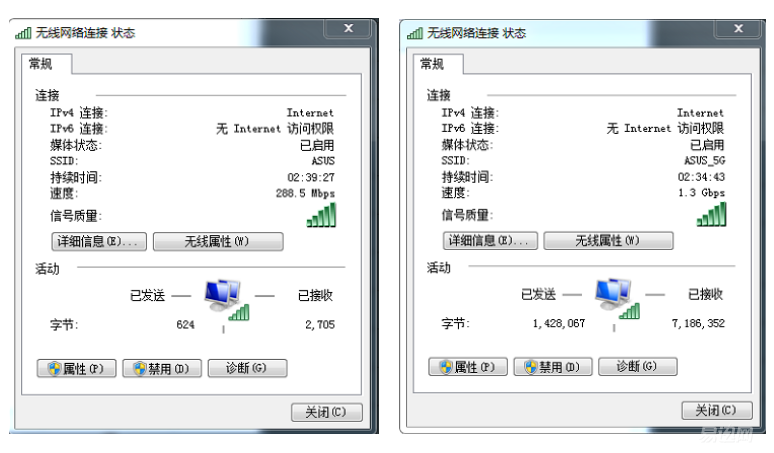
3, test PC and motherboard-side network card chip
All of them were deployed many times ago from Qinghai and Tibet to explore their homes. They have not tossed these years.
Htpc1 : CPU: Intel I5-3450 boxed Motherboard: Asus P8H77-M
Hard Disk: HDD Western Digital WD1003FZEX (7200rpm 64M SATA6Gb/s) Network Card Chip: Realtek RTL8111E
PC2 : CPU: AMD Phenom II 955 box Motherboard: ASUS M4A89GTD PRO/USB3
Hard Disk: HDD Western Digital Blue Disk 1TB (7200rpm 64M SATA6Gb/s) Network Card Chip: Realtek RTL8111E

Move the machine to a small number, dragging it around, simple and unwieldy, it's not easy for a person to toss, everyone pats!
4, storage devices
QNAP ts-453mini+WD red disk
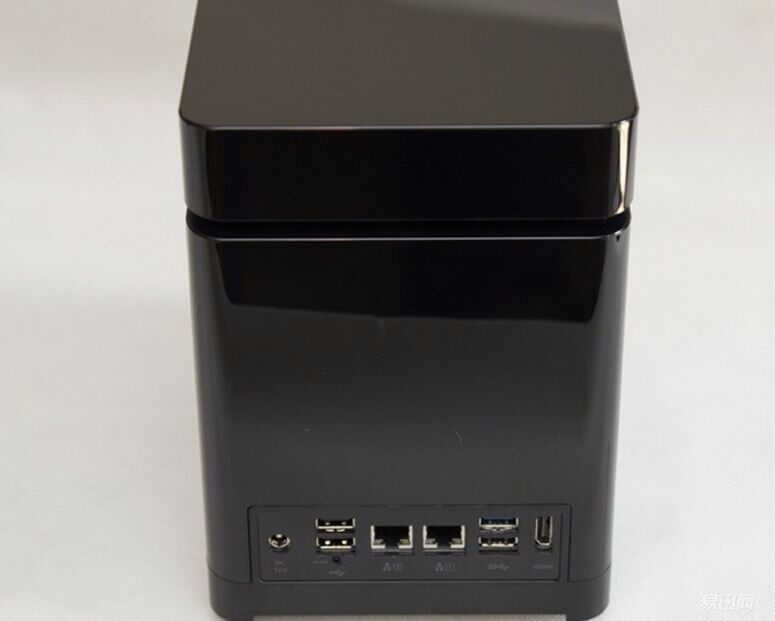
CF Card - Toshiba 1000X 32G
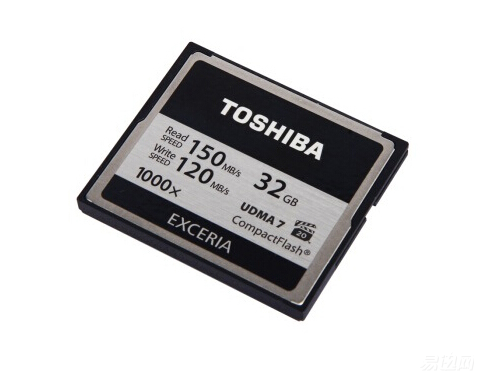
Measured reading and writing

The card reader drags the leg, writes 90M, reads about 145M, the influence for the test is not too big.
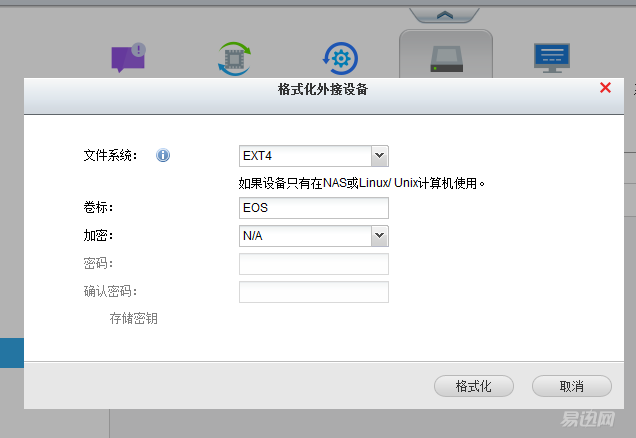
It is said that EXT4, speed bonus?
5, software
FastCopy
(II) Wireless signal strength
Room map
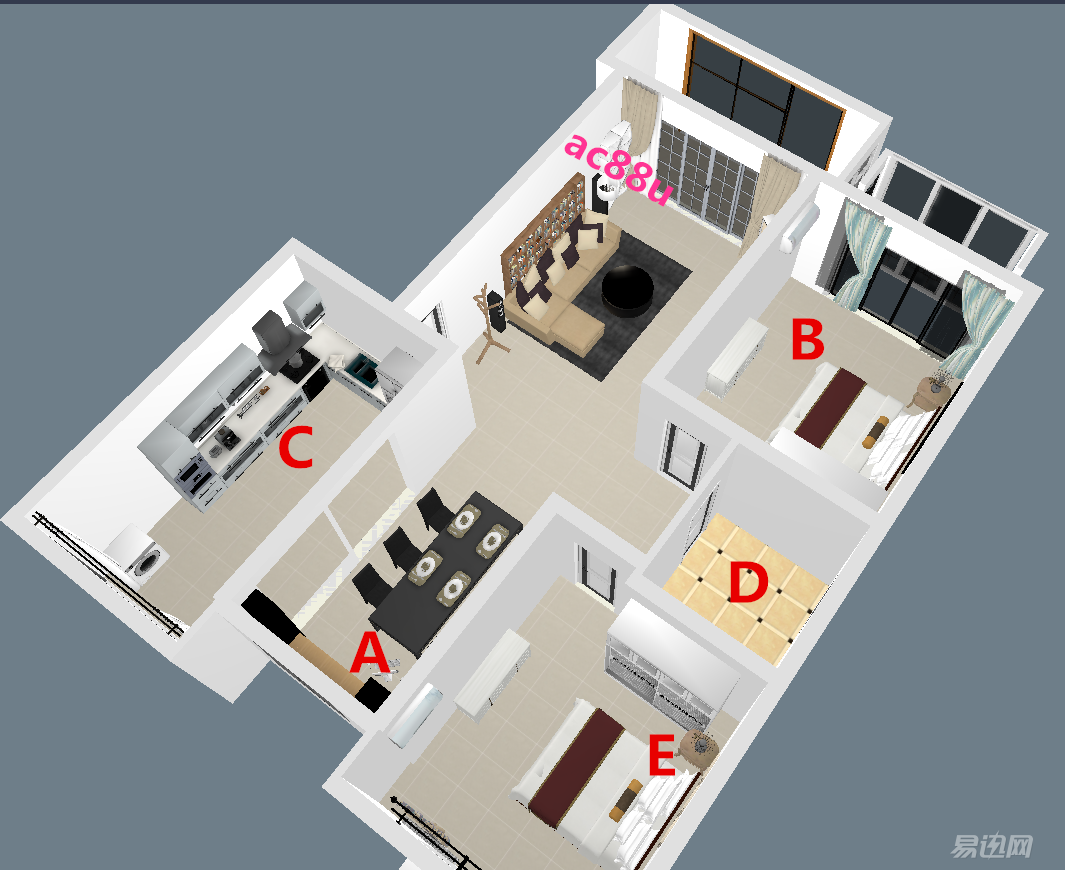
100 flats of second-hand school district houses, routers are placed in metal shelves in the southeast corner of the living room, point A is about 10 meters away; point B and the router are only separated by a wall, but because the wall hangs a lot of equipment in the living room, the signal There is interference; the kitchen at point C has a load-bearing wall and a refrigerator barrier; point D is “London†surrounded by plugging, and the signal is weak; E is because the network cable is damaged and the diagonal distance is furthest, and cats have been filled with electricity.
A point:
2.4G: -38dbm, 65% strength

5G: -41dbm, 61% intensity
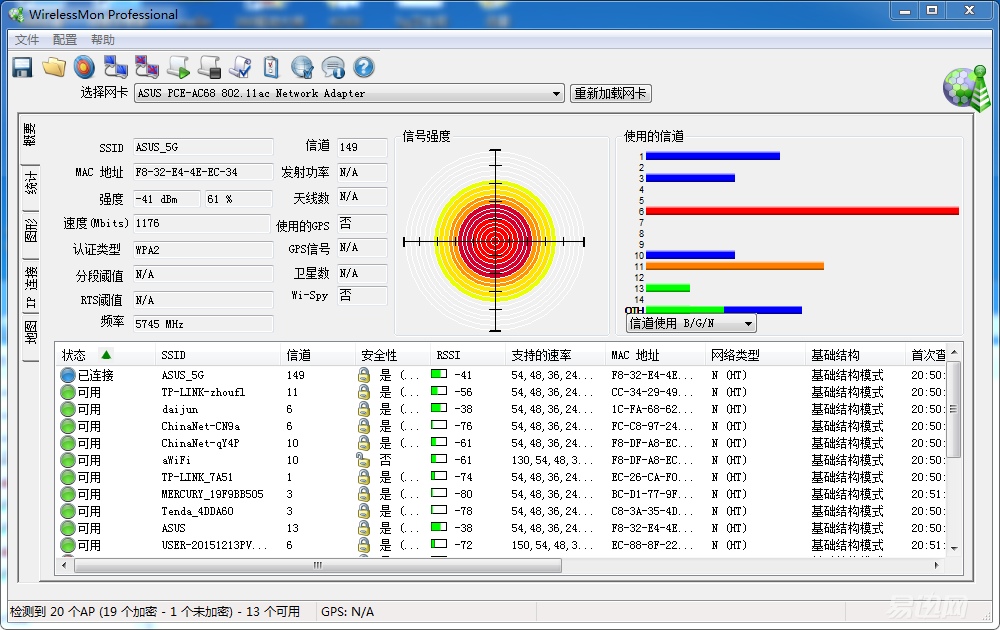
Point B:
2.4G: -44dbm, 57% intensity

5G: -50dbm, 50% intensity
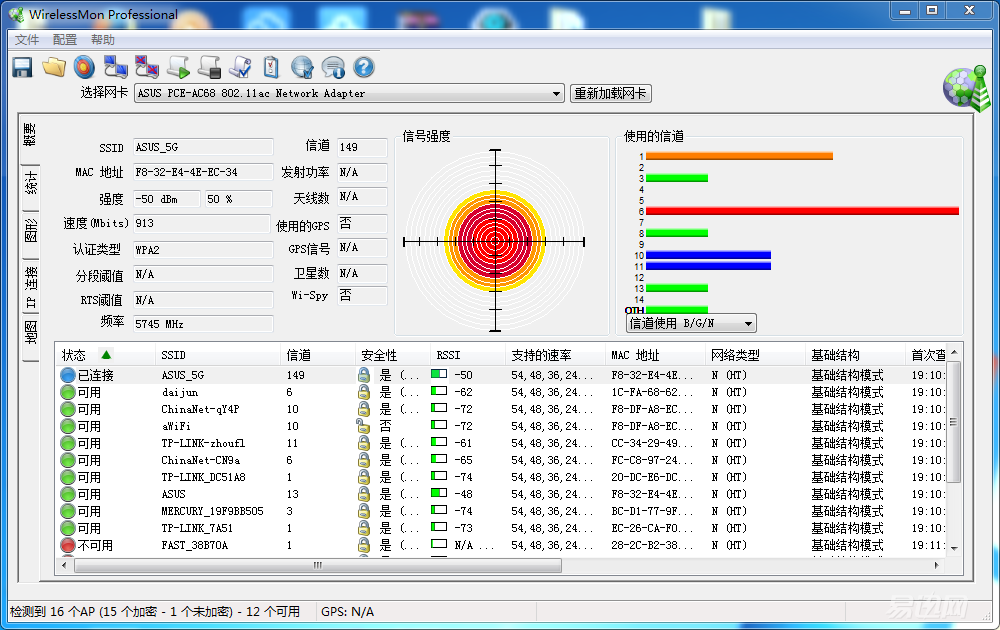
C:
2.4G: -48dbm, 52% intensity

5G: -47dbm, 53% of the intensity, is very different than 2.4G, which is the lowest numerical difference

Point D:
2.4G: -53dbm, 46% intensity
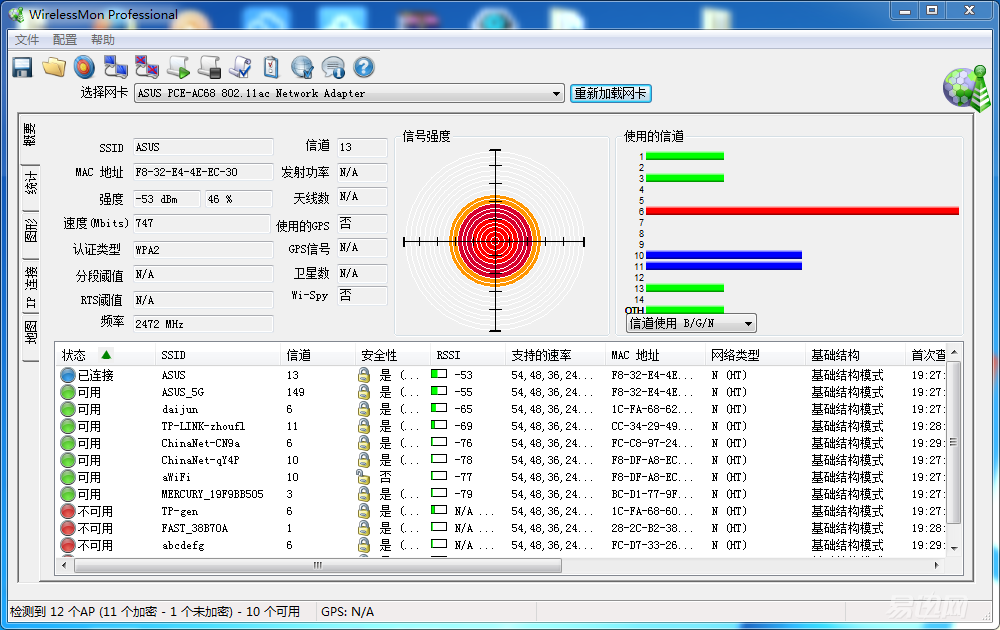
5G: -52dbm, 47% intensity, another strange phenomenon
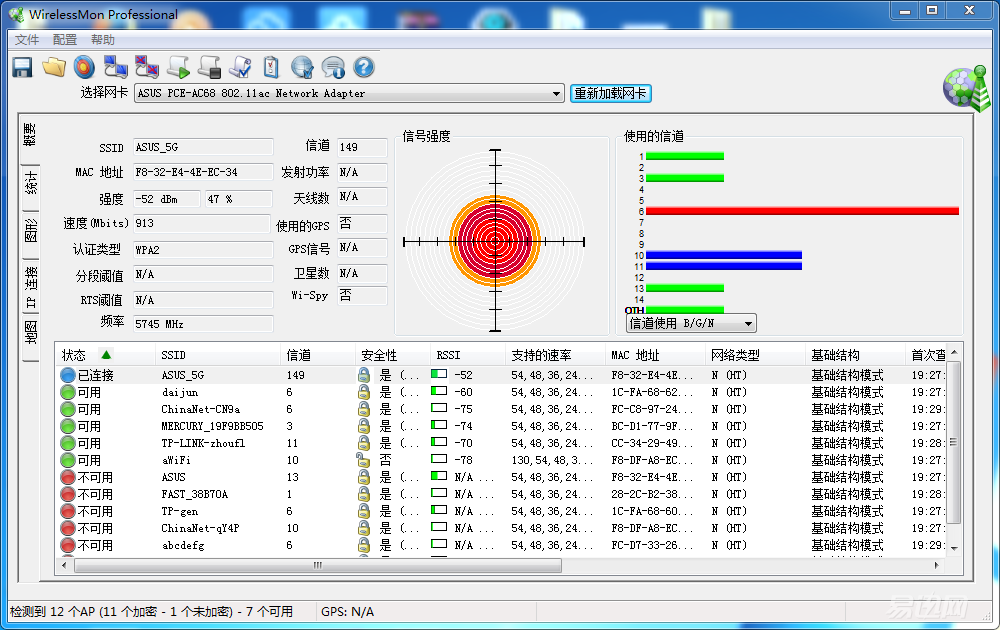
E point:
2.4G: -45dbm, 56% intensity
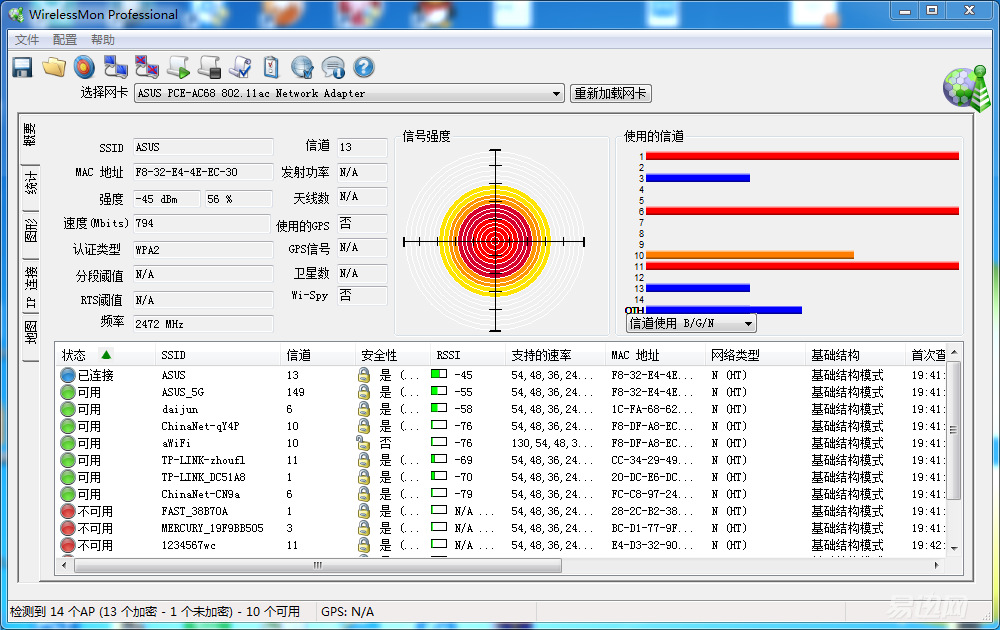
5G: -55dbm, 43% strength
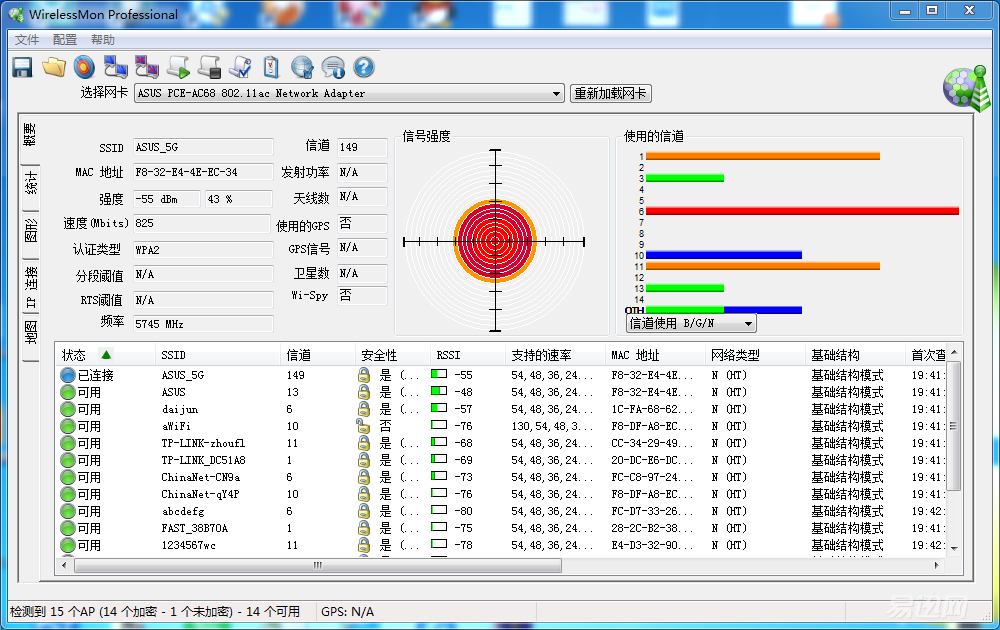
Chart summary:

Summary : AC88U support in the high-performance terminal equipment, covering hundreds of ordinary residential is no problem, as the 5G model more than 2.4G signal multiple times, it should be black apple AC-94360d 5G part of the driver to get The Asus beamforming signal enhancement technology and NitroQAM's addition, while the 2.4G part does not. If it is replaced by the original Asus PCE-AC68 it should not appear.
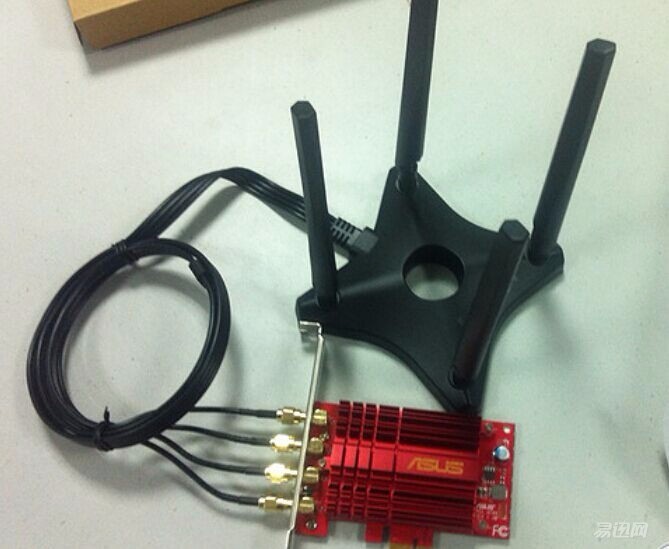
Digression, 4 antenna pce-ac88 network card is coming, then can really play rt-AC88U performance
(C), Lan to Lan transfer test - you can unplug your network cable
Note: All mounted devices and NAS hard disks are "disk mapped" to the PC, and the PC and NAS are connected to the LAN1 and Lan2 ports of AC88U.
1, Lan to Lan write

Wired access, up to 106.3MB/s
2, Lan to Lan read
 Wired reading 101.2MB/S
Wired reading 101.2MB/S
3, 2.4G to Lan write
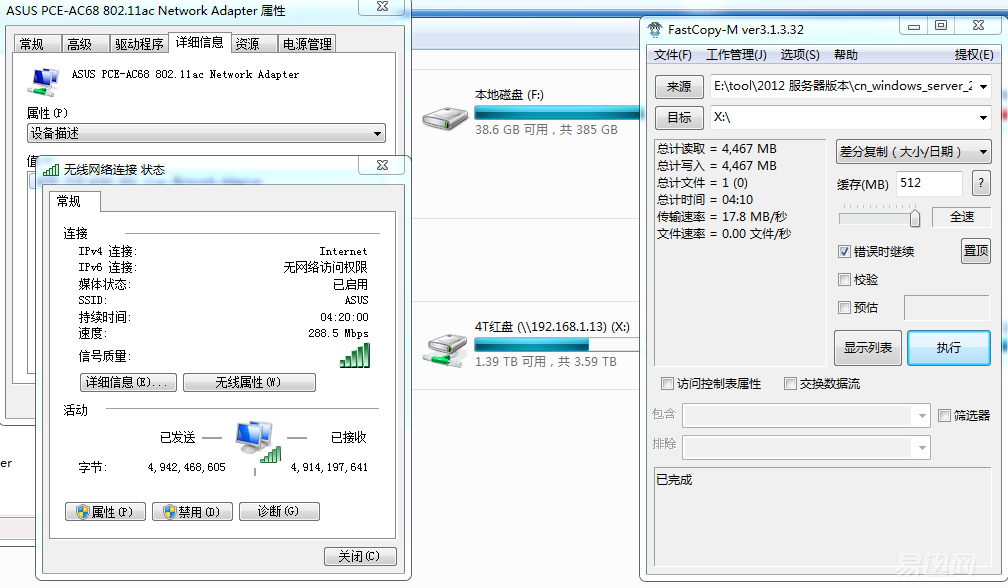
2.4G write speed is 17.8MB/S
4,2.4G to Lan read
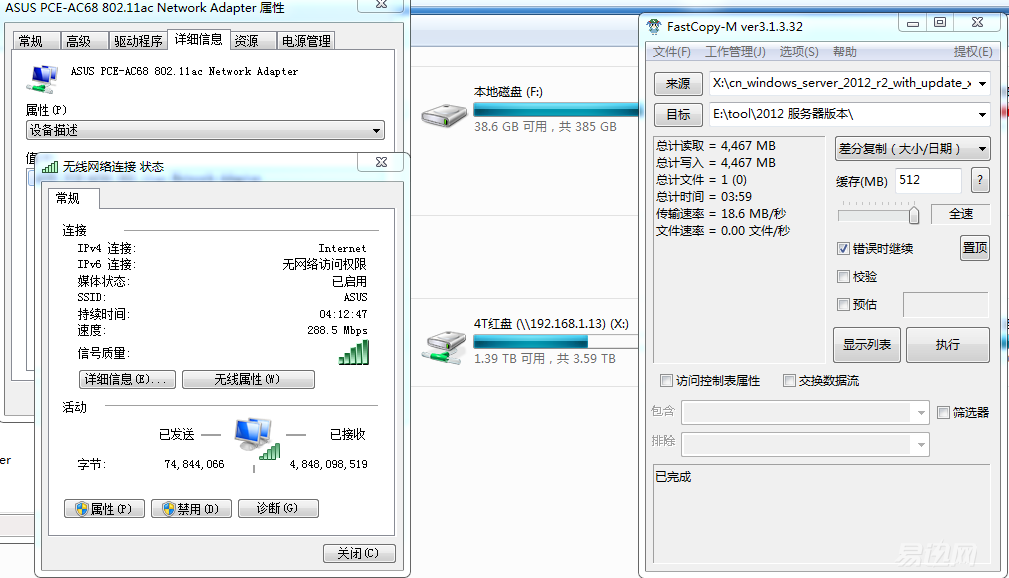
2.4G read speed is 18.6MB/S
5, 5G to Lan write
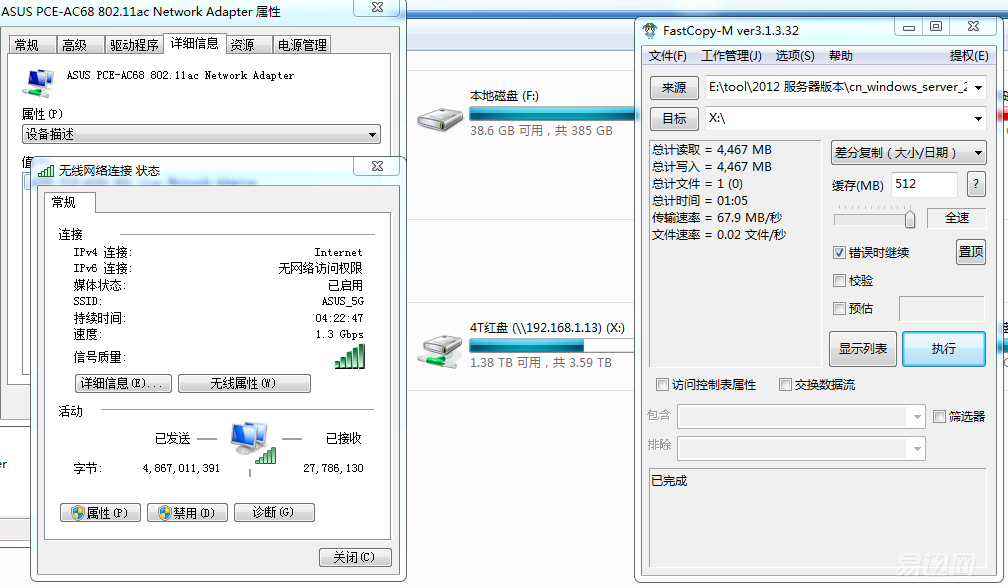
5G write speed is 67.9MB/S
6,5G to Lan read
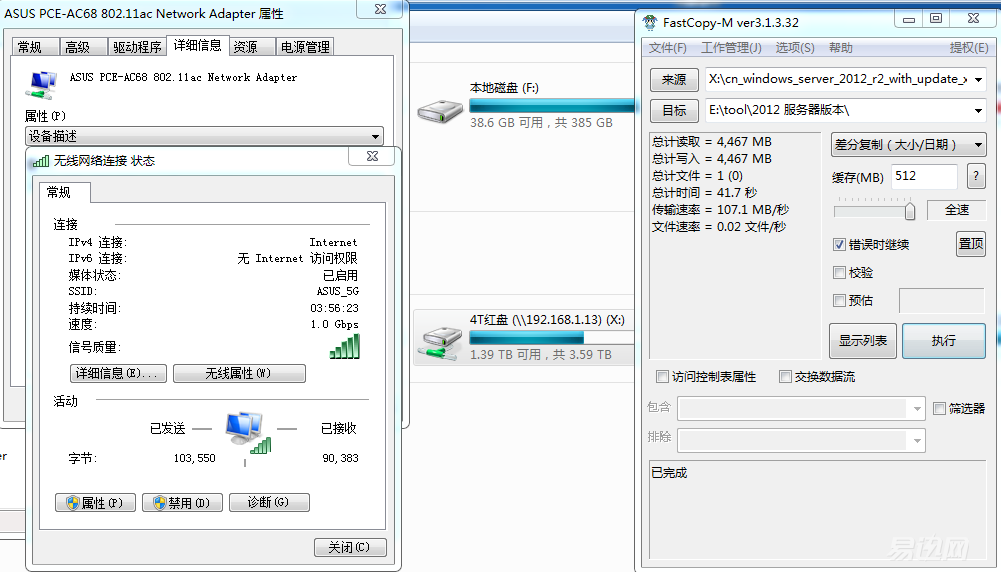
5G read speed is 107.1M/S
The speed of 5G is very exciting, you can unplug the cable, it is really awesome! ! !
(D), USB3.0 read and write test
All mounted devices and NAS hard disks are "disk mapped" to the PC, divided into USB3.0 anti-jamming on and off respectively read and write tests
(Note: In the ac88u testing session, the latest several firmware versions cannot support EXT4 format, so change to NTFS)
1, appetizers - AC68U USB2.0 wired read and write
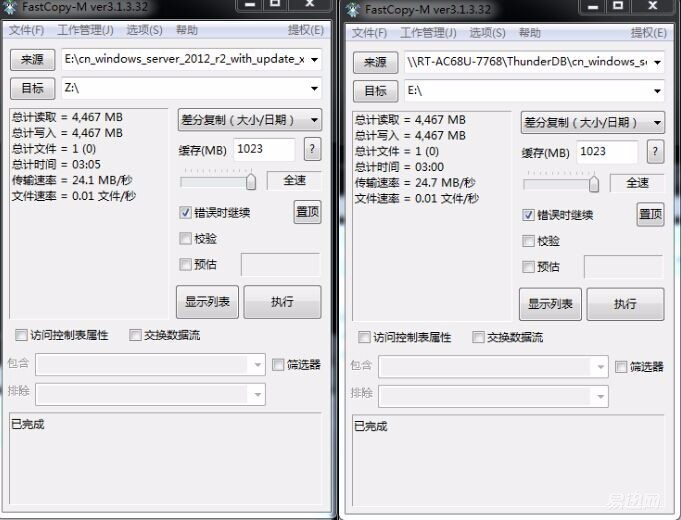
24.7MB/S reads, M24.1MB/S writes, and the R7000 netware gap is larger, basically bid farewell to the download, or use NAS.
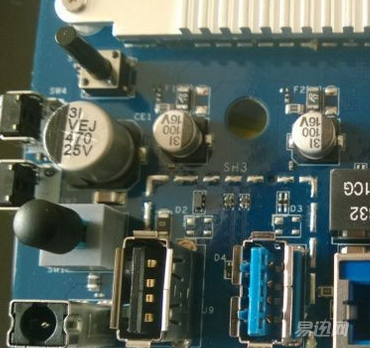
It is said that the USB port of the AC68U is not shielded, which also allows us to have great expectations for the AC88U.
2, ac88u open "reduce USB3.0 interference" state transmission performance test
A, wired read and write
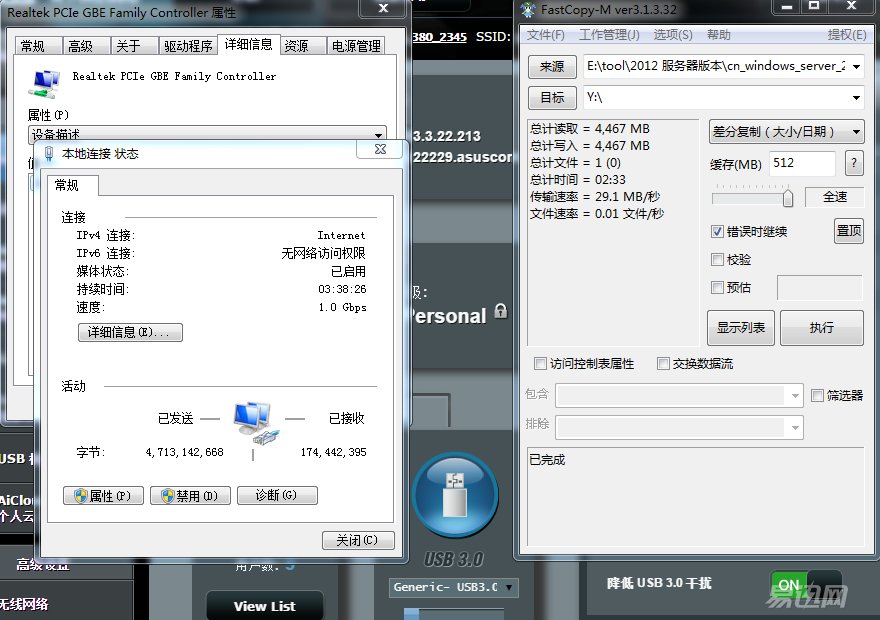
Turn on "reduce USB3.0 interference", wired write speed is only 29.1MB/S
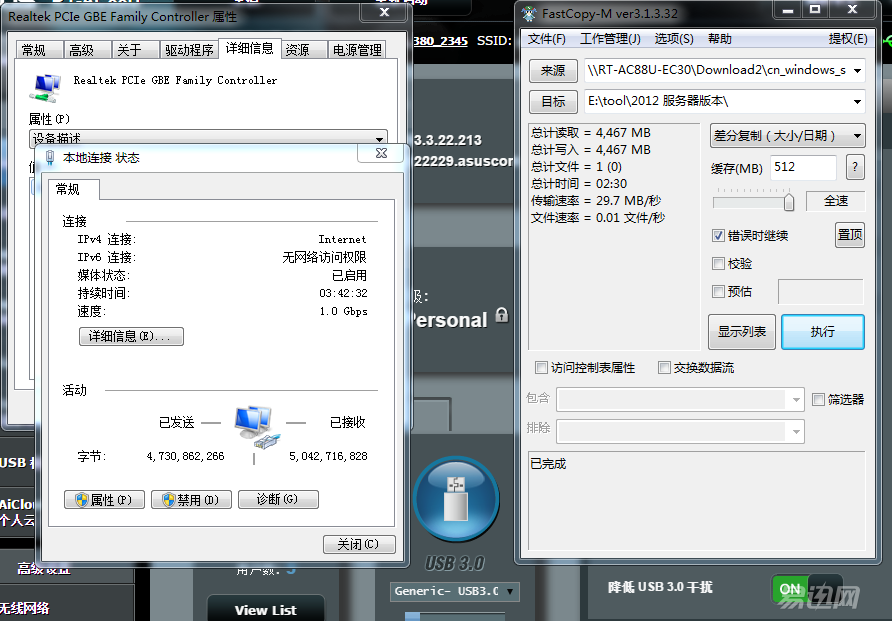
With "reduce USB3.0 interference" enabled, the wired read speed is only 29.7MB/s.
B, 2.4G wireless read and write
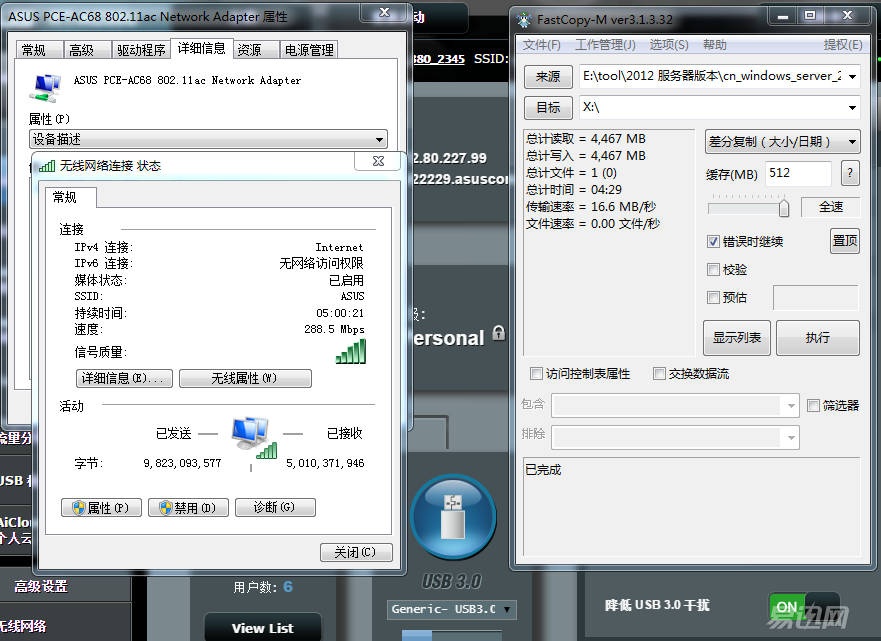
With "Reduce USB3.0 Interference" enabled, 2.4G write speed is only 16.6MB/S
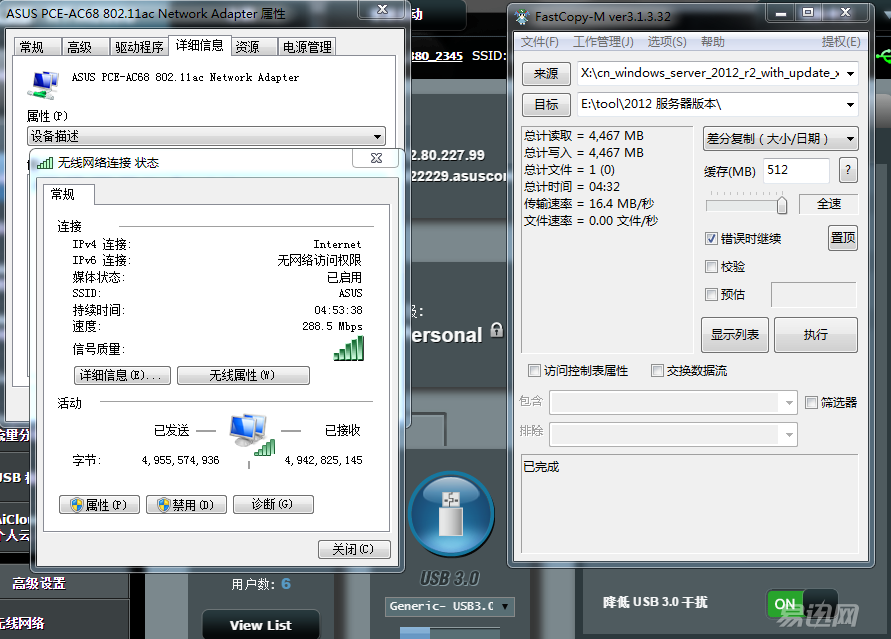
Turn on “reduce USB3.0 interferenceâ€, 2.4G read speed is only 16.4MB/S, but slower than writing?
C, 5G wireless read and write

Turn on “reduce USB3.0 interferenceâ€, 5G write speed is only 27.6MB/S
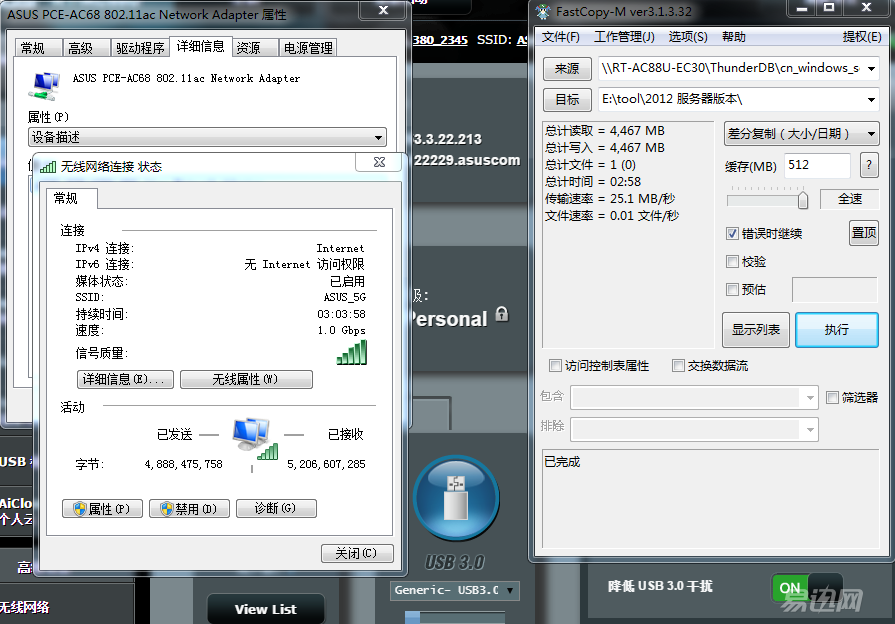
Turn on “reduce USB3.0 interferenceâ€, 5G write speed is only 25.1MB/S, slower than writing?
Summary: In the open "reduce USB3.0 interference" situation, whether it is wireless or wired, transmission performance is very scum!
3, close the "reduce USB3.0 interference " USB port read and write tests
(Note: After the anti-interference function is turned off, the mounting of the USB port becomes extremely unstable, and the copy from the CF is interrupted repeatedly, so only "write" data)
A, wired write

Turn off "reduce USB3.0 interference", wired writes up to 63.1MB/s
B, write 2.4G
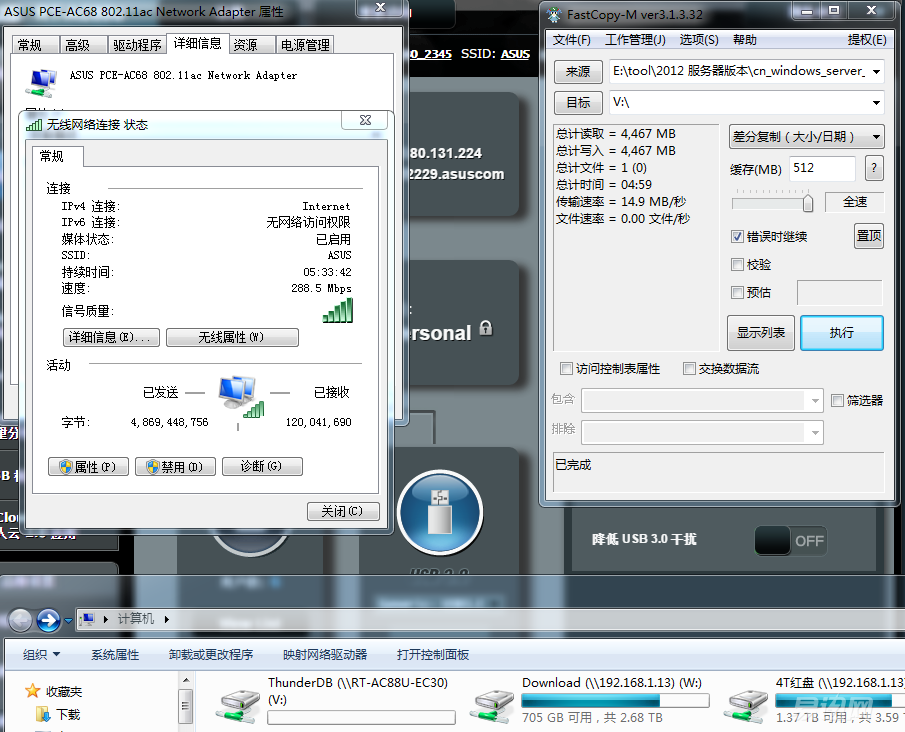
Close "reduce USB3.0 interference", 2.4G write 14.9MB/S
C, 5G write
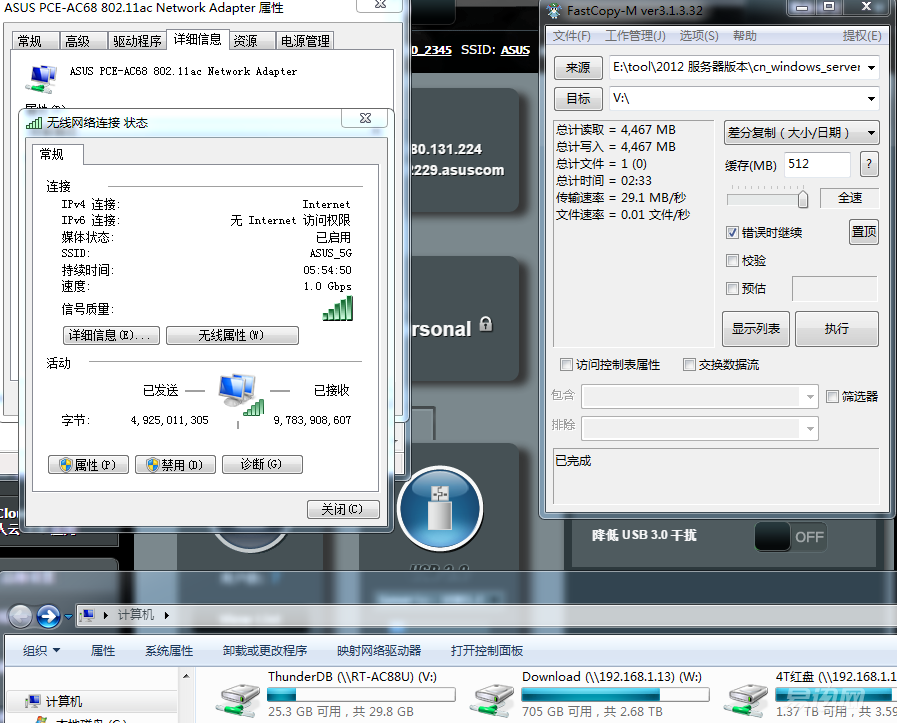
Turn off "reduce USB3.0 interference", write 5G to 29.1M/S
Summary: In the case of closing the “reduce USB 3.0 interferenceâ€, the wired writing has greatly improved, but the wireless transmission performance has not improved. At the same time, unstable wireless reading also causes people to worry about it. The so-called “fish And bear's pawn, "We have to choose.
Summary of all transmission test item data:

Summary: The AC88U's USB read and write Xiqiao can be greatly improved compared to the previous generation, and the data transmission can compete with the cable in the 5G state.
Six, port aggregation
With the advent of 4K and higher standard audio and video files, home users have also begun to request the simultaneous transmission of “big data†within the LAN. In order to extract the bandwidth of the existing “Gigabit LAN†as much as possible, it is ineffective. Under the premise of "10 Gigabits," many products began to play "link aggregation." The second part talks about AC88U's 8-port Lan, which is actually two switch modules. Lan1~4 are BCM47094's own Gigabit switch modules, where Lan1 and Lan2 support link aggregation, and Lan5~8 are crab RTL8365MB switch chip extensions. Therefore, when testing, Lan1 and Lan2 are inserted into the NAS corresponding to dual network ports, and two PCs are connected to Lan3~4. Set as follows:
Routing side: Lan LAN settings
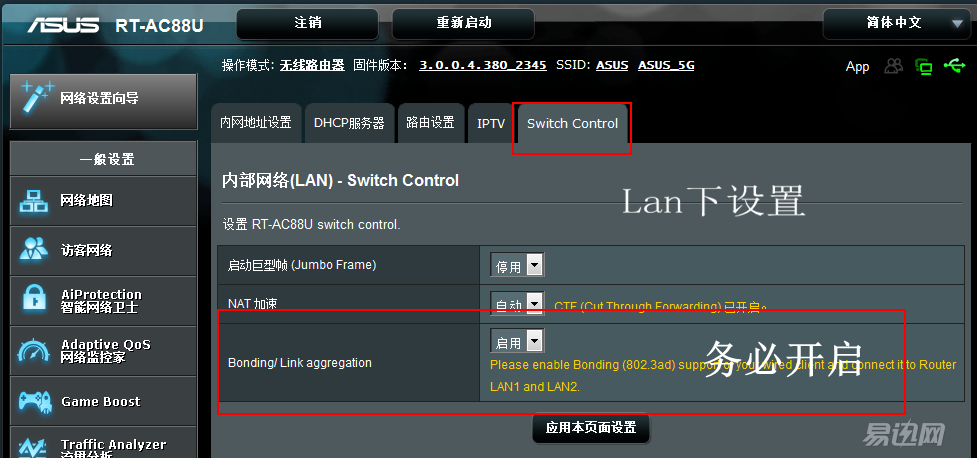
NAS: Take QNAP as an example. In the network setting, enable the trunking group for the port and select Balance-tlb mode. I'm determined after one trial.
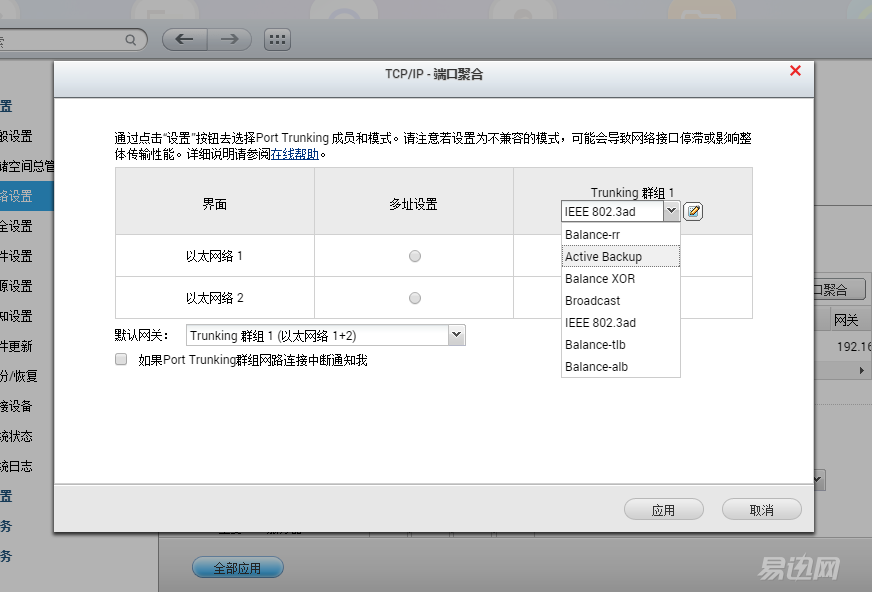
After confirmation, the IP address can be fixed in the edit, and the aggregation operation will be more stable (Note, I did not choose a fixed IP)

Because Asus changed the aggregation rule, the latest firmware on the official website v380_2345 changed the " LAG " bonding mode to " Static LAG " instead of the "802.3ad" at first, so you are looking for a subordinate with the aggregation function for the router. When you switch, you must consider whether its aggregation rules and ac88U can cooperate, such as LACP mode. However, I also found that "802.3ad" can be aggregated normally when using other firmware, and the following tests are all in this mode.
Test result: NAS two hard disks different files are sent to two PCs respectively.
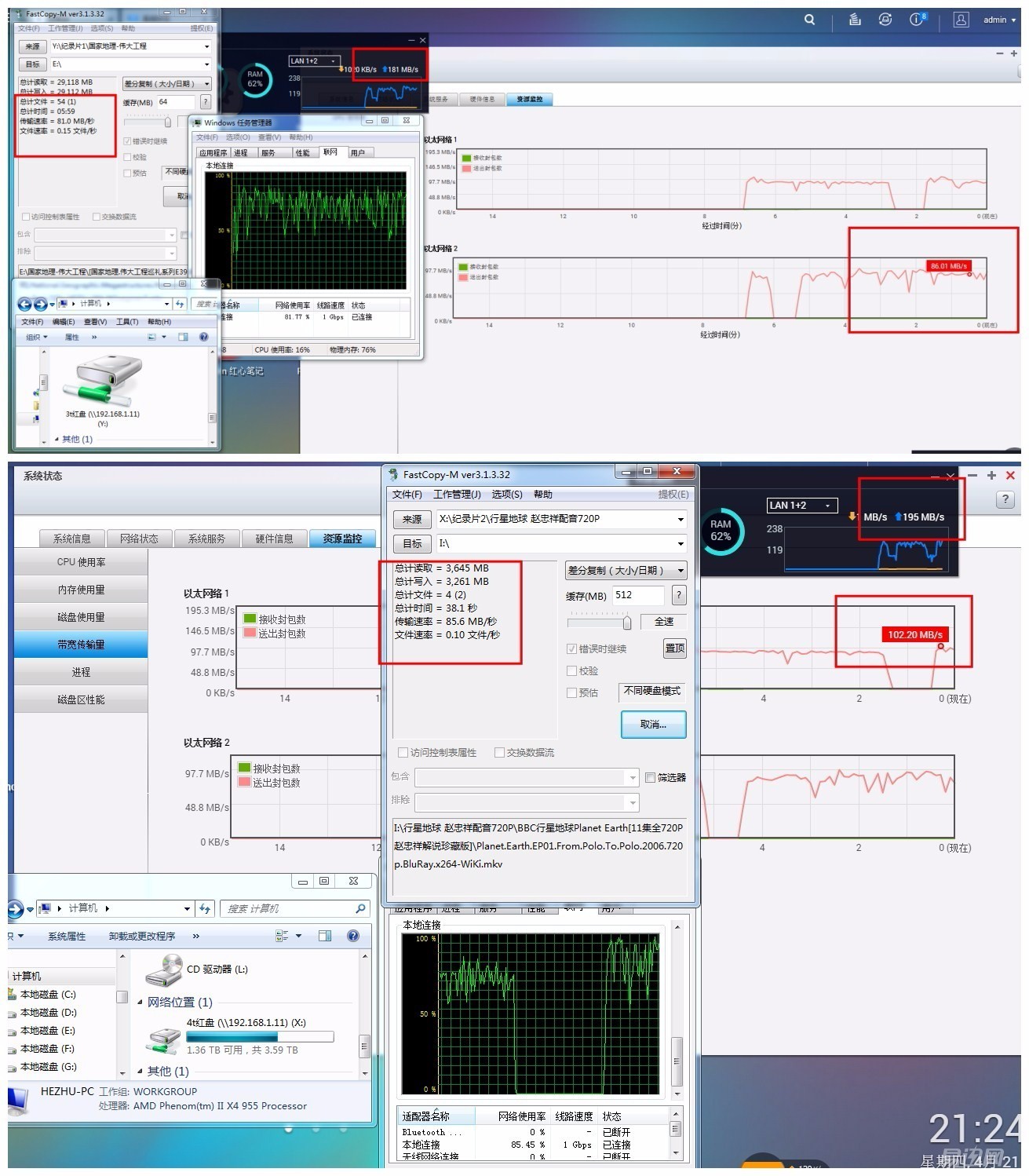
The real-time data is: NAS always sends out bandwidth: 181~195M, PC1 accepts bandwidth: 81MB/S; PC2 accepts bandwidth: 85.6MB/S.
Two PCs respectively write data to different hard disks of the NAS. The pictures are spliced ​​as follows:

The real-time data is: NAS total acceptance bandwidth: about 117M, PC1 write bandwidth: 81MB/S; PC2 write 90.2 bandwidth: 27.6MB/S.
The port aggregation of the RT-AC88U is really only the most basic function. It can be sent only if it is not received, and it can only be between LAN1 and 4, if you want to really experience the complete aggregation.
Summary : The theoretical value of link aggregation, NAS out spew and swallowing is 200MB per second, but the speed limit of a single computer Gigabit LAN is 100MB, so multiple tests will be needed to know if it is successful. In addition, you have a few hard disks installed in your nas. Are they mechanical or solid? Whether or not the raid is grouped has an effect on the value, so there are still many bottlenecks in practical applications. Each link needs to meet the 2.0+ standard. For example, if the PC needs a dual network adapter, the complete aggregation function at the routing end, the switch, and the NAS all need to be able to truly enhance and stabilize the speed.
Seven, mobile app
1, commonly used applications
Asustek's firmware has already hit the opponents to find teeth. Now it has further introduced a mobile app to facilitate the experience and transfer of equipment. There are several commonly used applications.

ASUS Router, AiCloud, Aicam, Download master, and Manual Wakeup


ASUS Router as a mobile login, you can view basic information such as network connection devices, real-time traffic, and router status at any time. You can perform backup and restore, DNS settings, and even login to access the router for all firmware operations in the third section.
2, AiCloud application
Access USB3.0 Mounted Devices
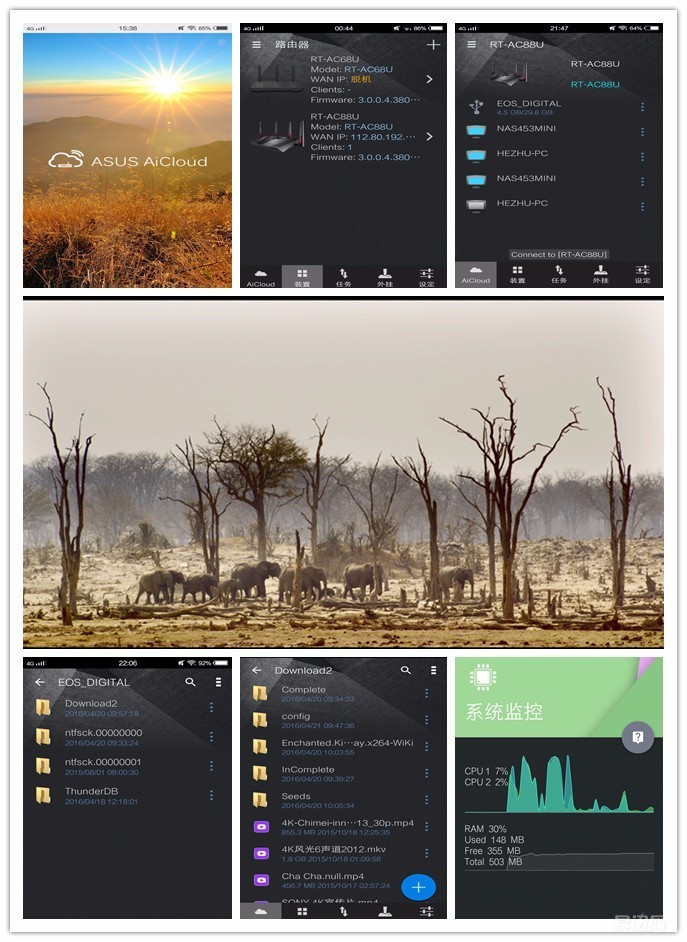
Wake up or access other devices on the LAN, such as NAS
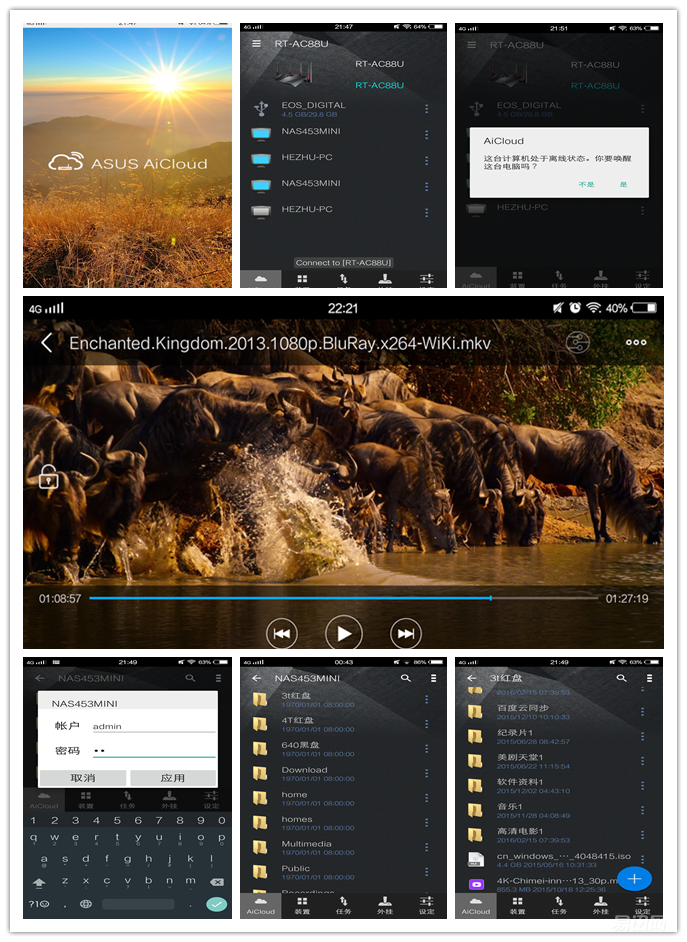
Can access and read mounted devices at any time, including USB devices and NAS, because the phone performance is not enough to play 4K, so choose "BBC14 annual record masterpiece "Magic Kingdom Enchanted Kingdom 3D"" as an example, the entire process without pause, system load Very small, dual-core is within 7%, memory usage is about 30%.
Summary : According to past experience, mobile APP and application suite are strengths of NAS vendors. With the deepening of mobile Internet, as a hardware vendor with “soft powerâ€, Asus clearly wants to further amplify the weaknesses of old rivals such as net-nets. This is definitely another trump card for differentiated competition. It is very attractive for me to look for simple white papers , and also to promote software for her "Huawei" NAS. (PS, currently Hua Wei is a QNAP OEM, I do not know whether or not?)
Eight, 4K playback
The previous section said that ASUS RT-AC88U is to support 4K and other large files LAN transmission and playback, in fact, the previous flagship AC68U can also, but the load is too high, especially the memory is often 80% -90%, resulting in extremely high heat.
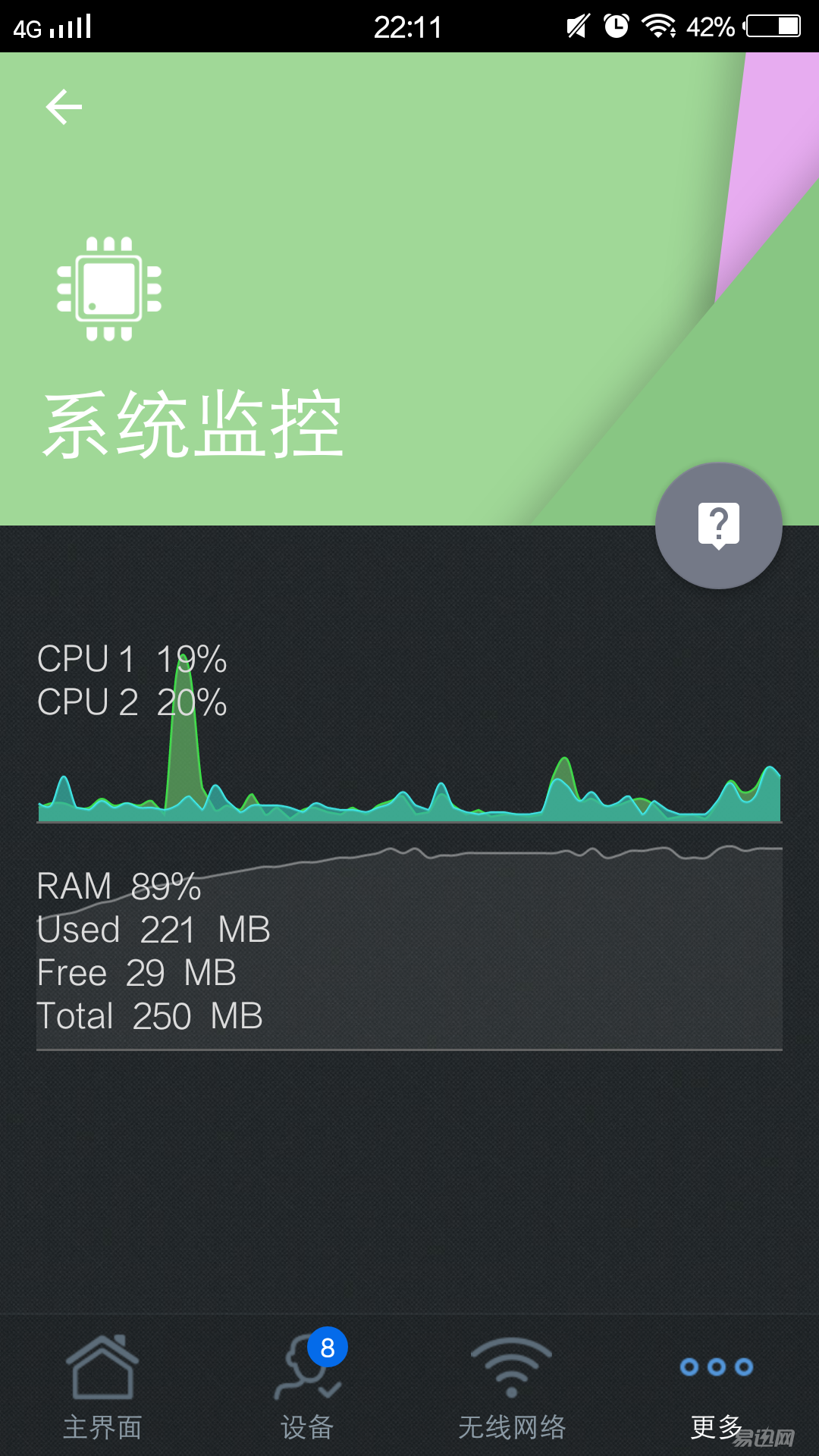
The ac68u's 250M memory handles big data video files, and it's very painful. The curve below remains high. So we should have confidence in doubling the 512M. Well on the video screenshot to see the load situation:
Traditional 4K roast duck 30P/S high stream, USB3.0 mount, memory load at 42%

Traditional 4K roast duck 30P/S high stream, USB3.0 port mount, memory load at 42%
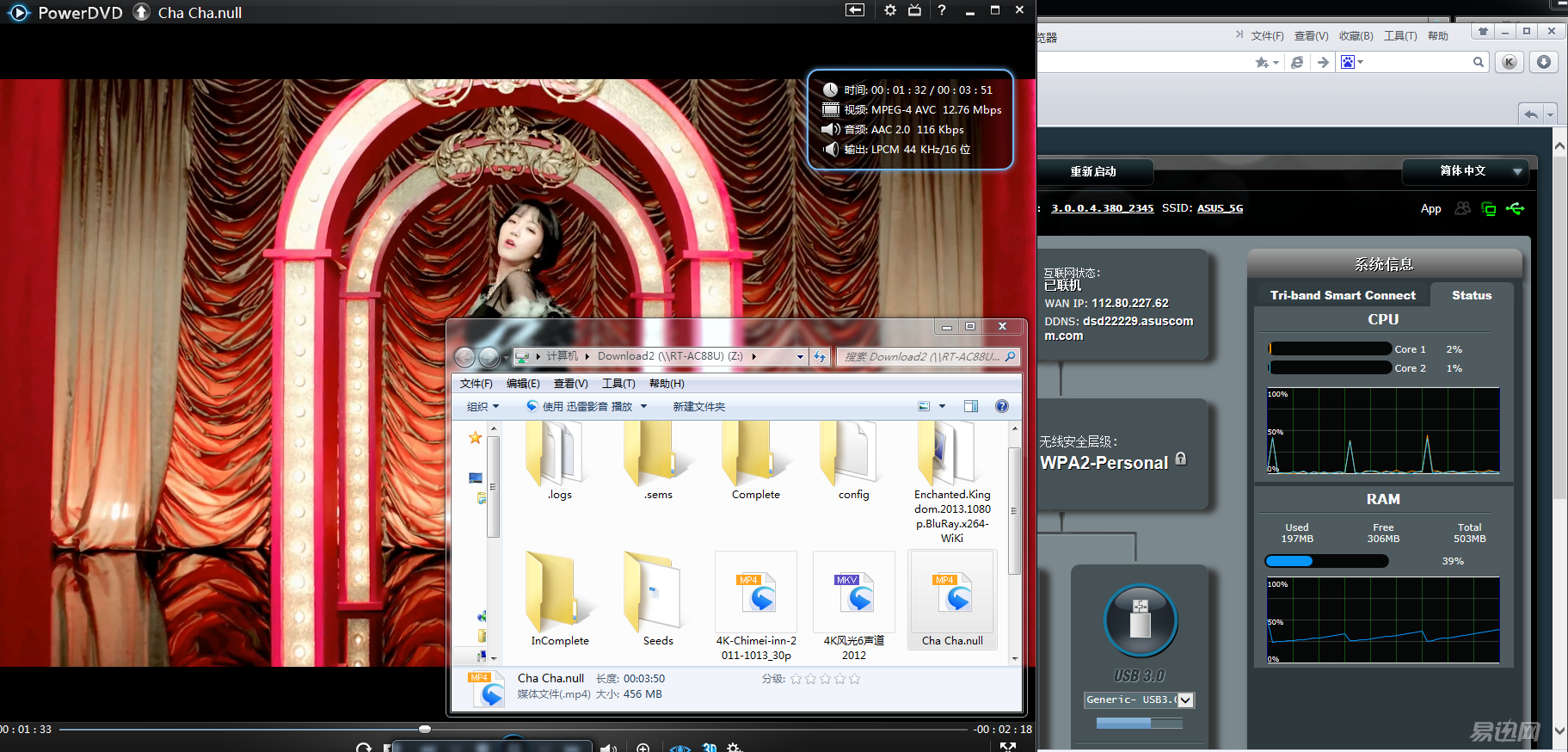
Liked to see Korea's "One Face Long Leg" combination, USB3.0 port mount, memory load of 39%
Nine, summary
advantage:
1, ac88u for the current sale of high-end home router configuration, BMC4709 processor +512 MB RAM and 128 MB ROM with enough to cope with all network scenarios.
2. The appearance is overbearing, ROG pedigree of red and black is visual sense, the value of belief bursts, the power configuration is sufficient, and the interface is rich in playability.
3. Various advanced wireless frequency-up and tracking technologies ensure the stability and reliability of links.
4, 2 LAN ports support link aggregation, double the bandwidth rate, LAN 4K shared play without stress.
insufficient:
1, high specifications bring high heat, a large range of cooling holes and dust accumulation
2. The horizontal non-vertical model occupies a large area, and the frosted surface is likely to accumulate dust and fingerprints;
3, the exchange chip aggregation performance is weak, only sending does not accept, and can not allow all 8 ports to achieve polymerization.
4, the most critical price, all similar high-end routing prices are high, sigh!
As a AC5300, AC68UAC87U on the top of the high-end routing, Asus with "Tianji horse racing" approach, take ac88u "under the rush", on the one hand during the configuration period to the top level, on the other hand in the firmware and mobile software Roll opponents. It is an excellent marketing tactic for us who like to frequently "calculate" whether it is "worth buying". An AC87U+ aggregation switch is obviously more than this price, not to mention AC88U frequently has promotional activities, often with a good price of 1399 to 1499.
Of course, I am more concerned about the fact that ASUS has dared to break through the boundaries of existing technologies and that in the face of difficult technical breakthroughs, it is wise to choose effective integration and cross-border development. Like “hybrid†technology, it is still very competitive at this stage and it is easy to trigger future innovations.
The End~~ Thank you for sharing me~~